64 Halloween Room Decor Ideas 2025: Stylish, Safe, and Spooky Inspirations for Every Room

Halloween is coming soon- are you prepared to turn your house into a haunted house without losing comfort or style? Whether you’re planning a creepy movie night, setting the scene for trick-or-treaters, or simply want to add some Halloween room decor flair to your everyday spaces, 2025 is bringing bold new ideas that are as smart as they are stylish. Whether it is changing LED lights with a tap or projection effects to tell a ghost story on your walls, the trends of this year are all about immersion, practicality, and unforgettable vibes.
This article will take you through room-by-room decor ideas that combine spooky aesthetics and comfortability. You’ll discover how to create a cinematic lounge, a moody-yet-sleepable bedroom, a spooky kitchen that still cooks, and even TikTok-ready setups that teens will actually love. And yes, we are already working on the newest Halloween decor ideas, tech upgrades, and affordable options to make your 2025 Halloween the most memorable one.
Trend Forecast 2025: The Big Halloween Room Decor Ideas Shaping The Year
I predict 2025 will swing dramatically toward immersive-but-subtle atmospheres: smart lighting, projection mapping that is not in-your-face, sustainable materials, and props that you can flat-pack after November 1. Rather than plastering every surface with kitsch, I design with layered light (think LED lighting strips, pixel-controlled bulbs, and candle-sim LEDs), moody textures (velvet, smoked acrylic, matte black ceramics), and cinematic soundscapes you trigger from your phone. It is a high-end, renter-friendly, and reversible effect, which is ideal in maintaining your home fashionable even after the holiday.
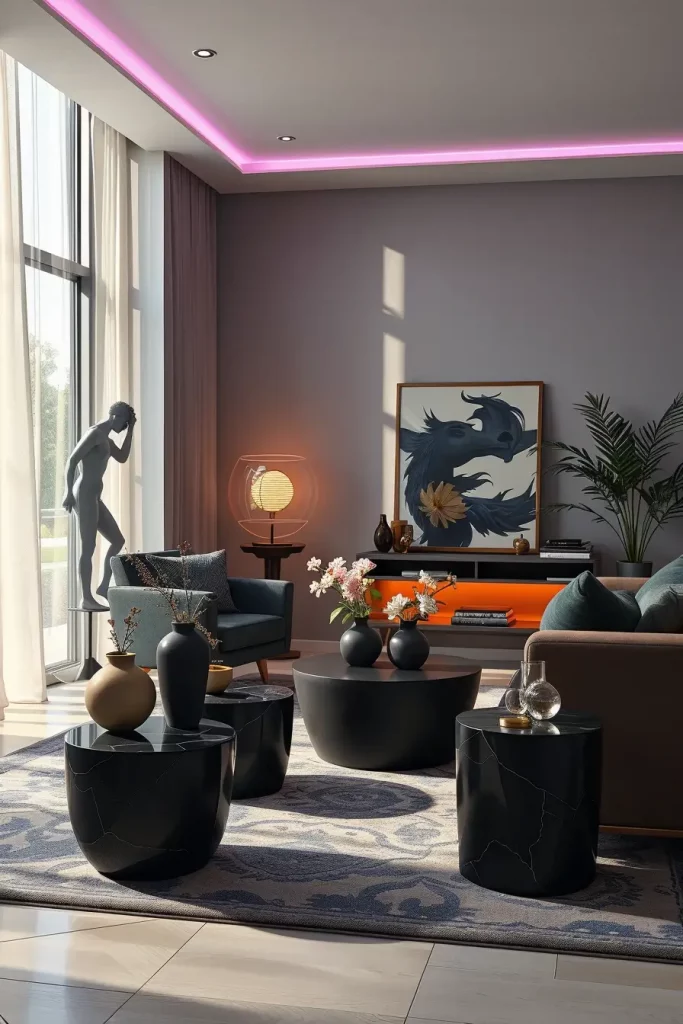
To do so, I grab app-controlled RGBWW bulbs, low-profile foggers with timed bursts, peel-and-stick wall silhouettes, acoustic panels covered in dark fabrics, and wireless battery sconces. I also add modular arches, faux-stone pedestals, and soft-to-the-touch “stone” planters (recycled resin) to create depth without heavy lifting. Some strategically placed mirrors enhance the atmospheric lighting and even the smallest rooms appear to be a haunted set.
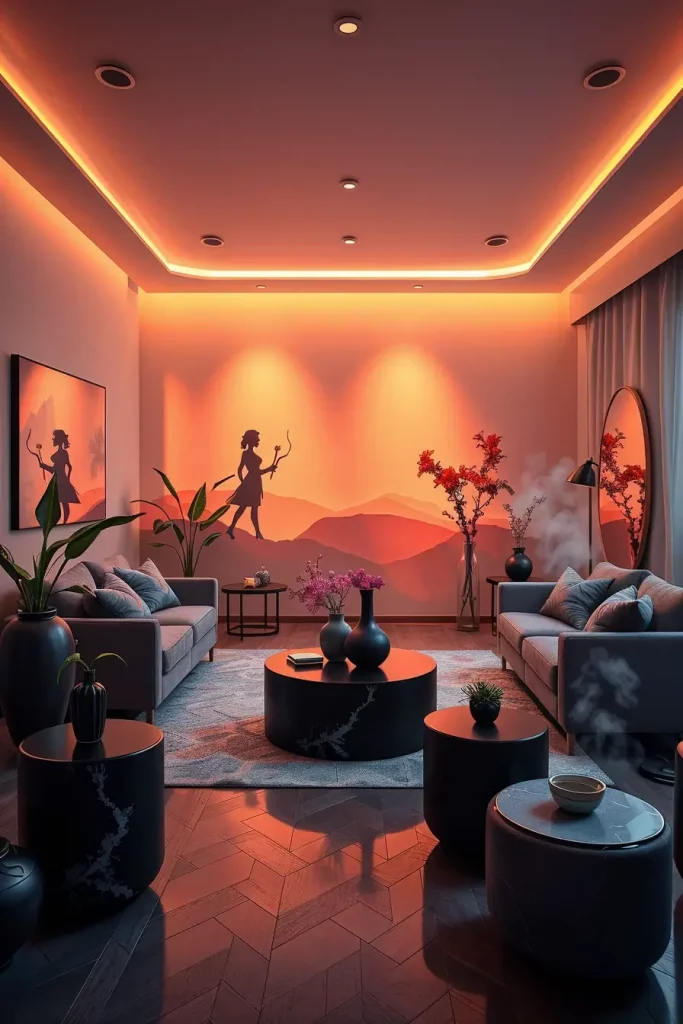
In my experience, lighting scenes and texture swaps are the quickest to change. Designers across major US publications keep repeating that light hierarchy (ambient, task, accent) is the secret to mood—Halloween is no exception. I concur: with the bottom layer being dimmable and warm, you can go crazy with the UV splashes, neon accents, or projection effects without blinding the eye.
What I would include: a sustainability checklist. I would always ask myself, can I use this in winter? Is it possible to donate or recycle it? I can not live without biodegradable webbing, fabric backdrops in place of vinyl and rechargeable puck lights in 2025.
Living Room Lairs: Turning Your Lounge Into A Cinematic Haunted Set
I create a set in the living room that seems like a movie still: I project thunderstorms on one wall, turn down the sconces, and use smart lighting presets to change the color of the room to ember-orange and then eerie moonlight blue. My favorite is to group sculptural branches, matte-black candlesticks with flicker LEDs, and a fogger concealed in a low planter so that the mist clings to the floor. The goal is to be immersive yet comfortable where the guests will be able to sit, talk, and watch a movie.
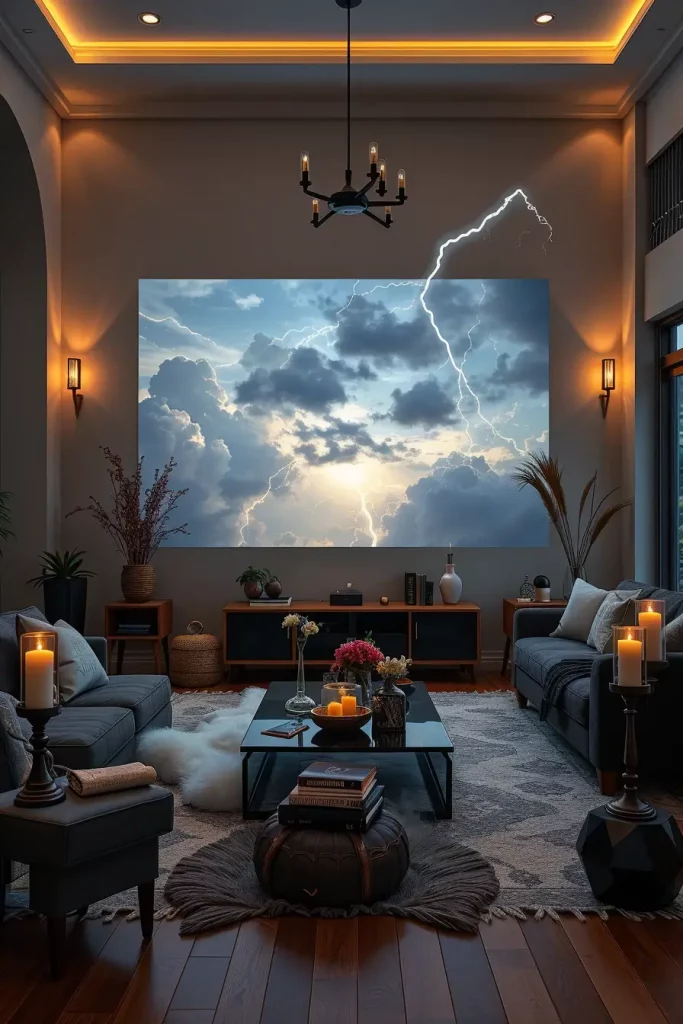
I specify a velvet or boucle throw in charcoal, chunky knit pillows in rust or oxblood, a blackened metal coffee table tray with bone-white ceramics, smoked glass hurricanes, and a layered rug (jute base + dark runner) to ground the look. A small haze or fog machine that is DMX or app controlled will allow me to pulse the effect at a party. To get the cinematic effect, I affix a short-throw projector to project old horror title cards or animated silhouettes on curtains.
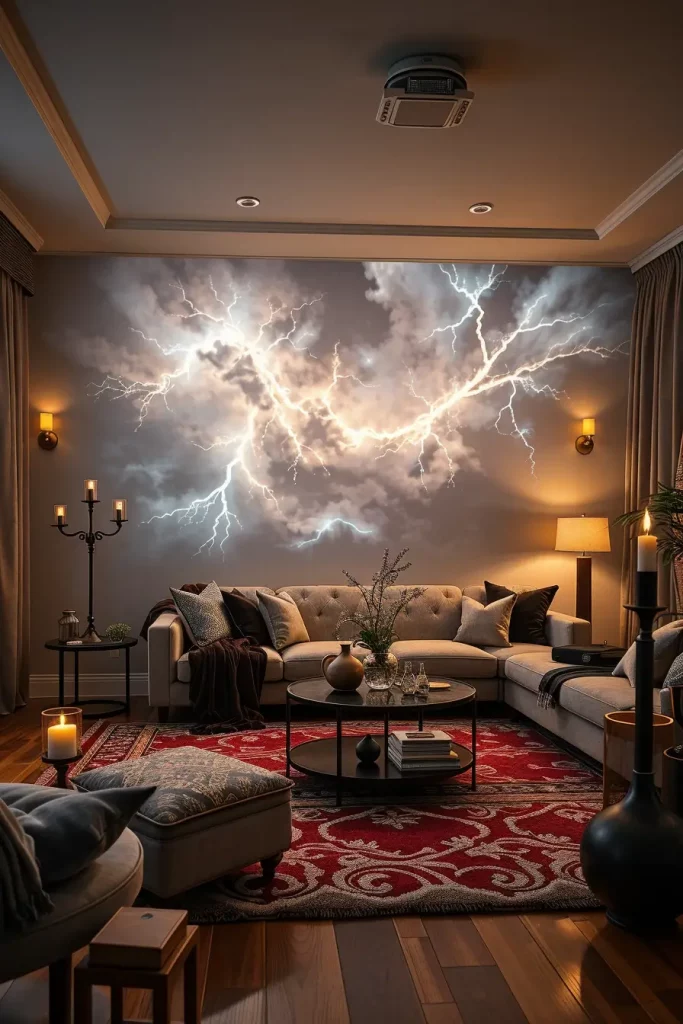
On a personal note, I prefer not to have too much plastic paraphernalia in the lounge, less is more. A designer trick I use: redirect light to architectural features (coffered ceilings, archways, moldings) to dramatize what’s already beautiful. It is a professional trick suggested by many lighting specialists to dim the general light and emphasize the vertical surfaces to make the room look spacious and dramatic.
What I would include: a layer of scent. A delicate smoky cedar diffuser or programmable aroma atomizer with the notes of forest after rain adds to the cinematic effect without smacking the guests on the head.
Bedroom Boos: Cozy, Moody, And Sleep-Friendly Halloween Room Decor Ideas
In bedrooms I go low-stim but seasonally rich. I do black, charcoal and burnt pumpkin layered bedding, install LED lighting under-bed strips on a deep amber setting, and substitute art with spectral, removable window films. The secret is atmosphere and circadian-compatible light, no retina-burning purples at 11 p.m. A blackout curtain with a cut-out moon shape can cast a spooky form on the wall with the bedside lamp switched on.
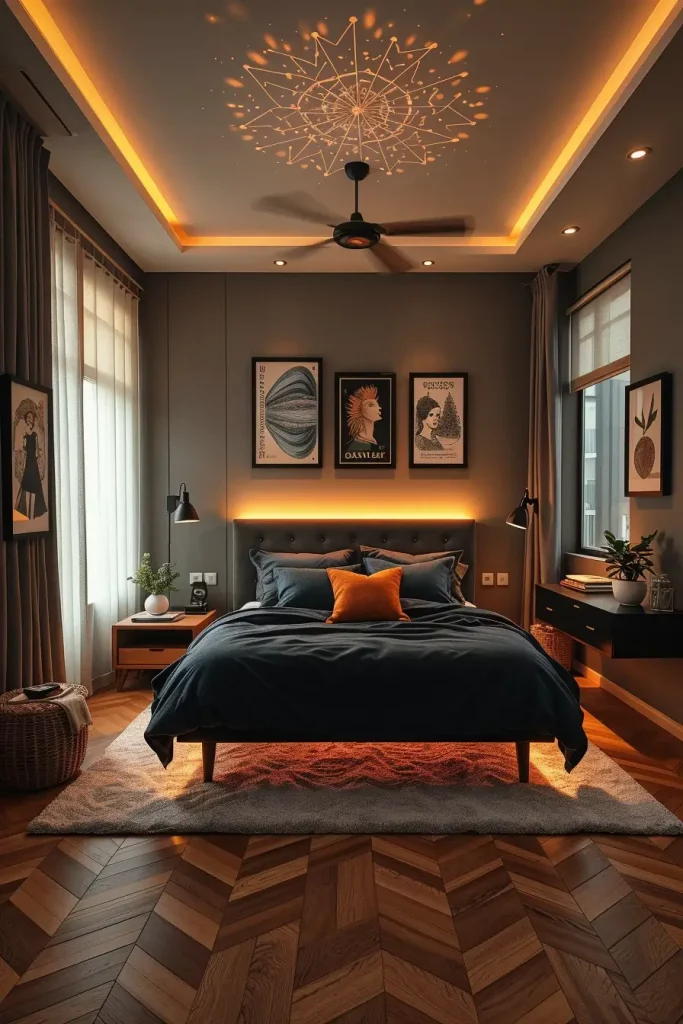
I’ll swap table lamps for dimmable, warm-glow bulbs, add soft velvet or faux-fur throws, matte black picture frames with vintage x-rays or botanical prints, and a slim floating shelf with ceramic skulls (matte, not glossy) and smoked glass votives. A fabric headboard in rich oxblood or forest green anchors the color story without sacrificing on sleep comfort.
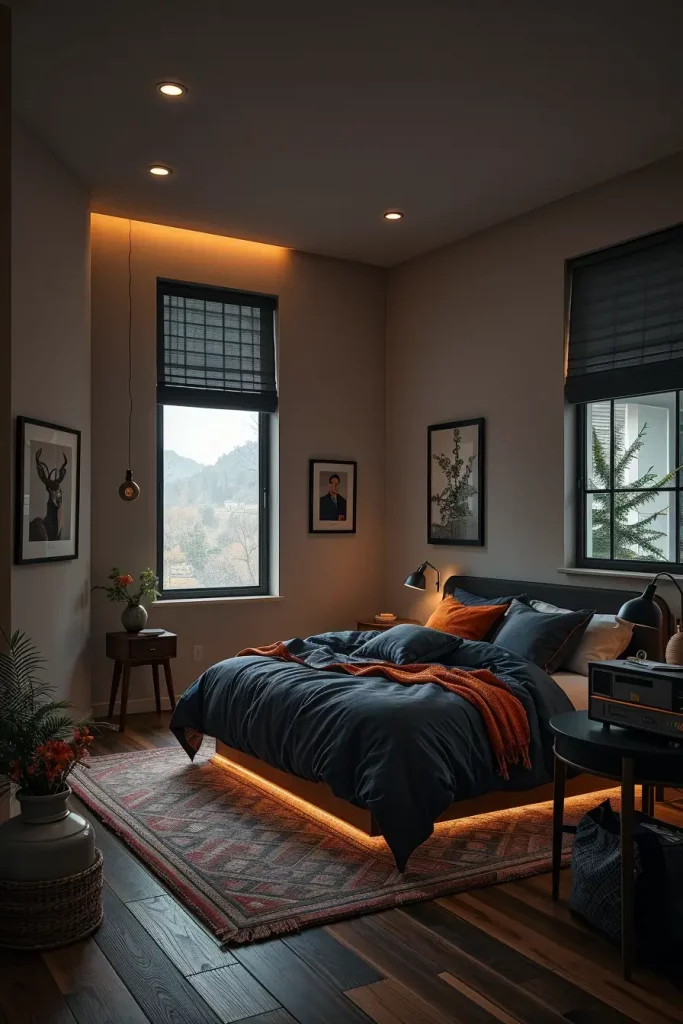
In my personal experience, circadian-compatible design is a must, and the design experts now commonly recommend warm-spectrum lighting in bedrooms. I live by that guideline: once the sun goes down, put your smart bulbs at 2200-2700K and use low-intensity accent lights to create the creepy effect.
What I would include: a programmable star projector with a very low brightness so that it does not cause light pollution at night. It doubles nicely to non-seasonal atmosphere.
Kitchen Cauldrons: Spooky Yet Functional Culinary Corners
I prefer kitchens to read witchy lab and yet be completely functional. I rely on matte black hardware, smoked glass jars with calligraphy labels and magnetized “potion” spice racks. A 2025 must have is under-cabinet smart lighting that can be switched between warm task lighting and creepy green party lighting. Chalkboard backsplash panels allow you to write down the recipes in some secret writings.
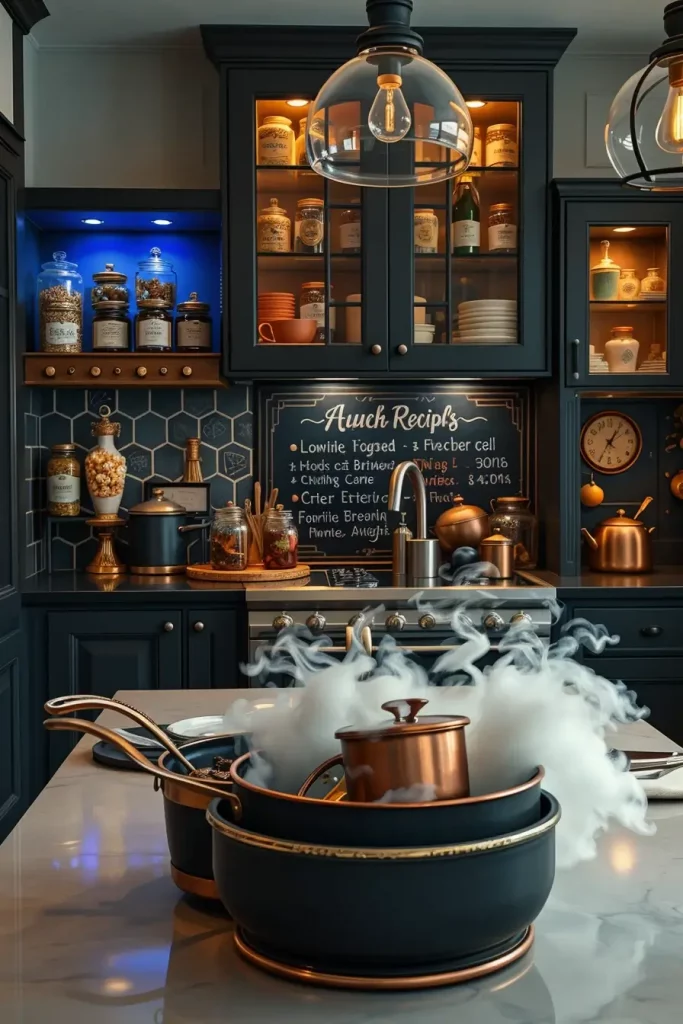
My favorite kit: matte black or copper cookware on display, a bony hand utensil holder, apothecary-style labeled jars, acrylic risers to tier the decor on counters and dim-to-warm LED strips under shelves. A small tabletop fogger inside a cloche (with food-safe separation) creates theatrical steam without compromising hygiene.
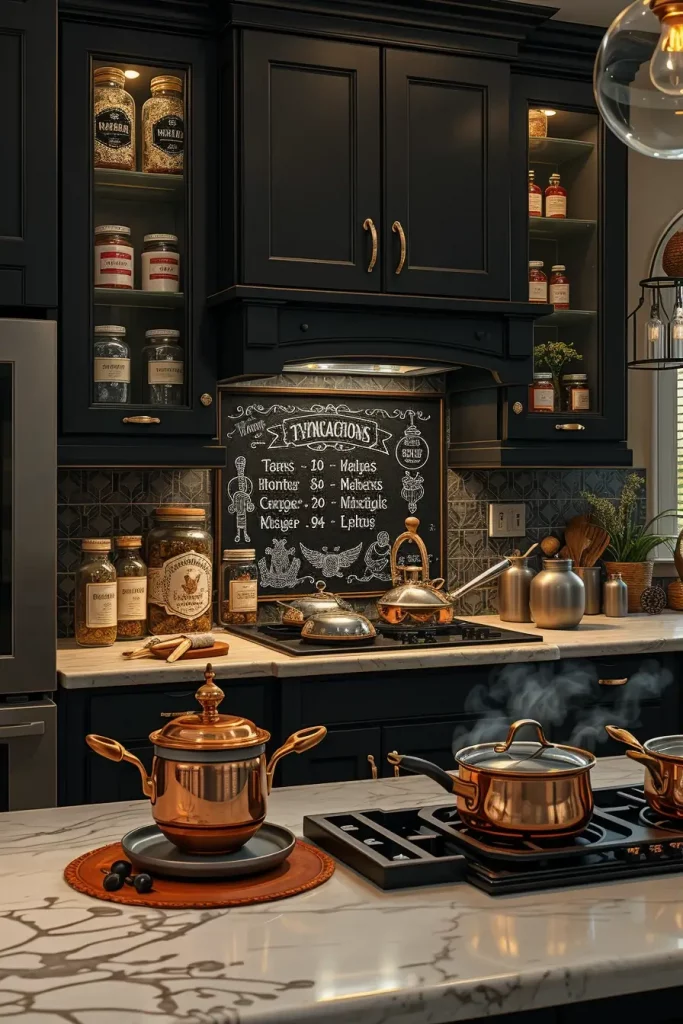
In my professional life, I never have cluttered prep areas. Food media experts usually say that cluttered counters are murder to functionality, so I gather all the spooky staging on one tray or in one corner. I follow that: one visual altar, The rest pristine.
What I would add: sound pads that are activated by motion and hidden under a mat or toe-kick that make a bubbling cauldron sound when a person passes by novel, but not obtrusive.
Bewitched Bathrooms: Fog, Mirrors, And LED Moonlight Effects
Bathrooms are ideal to stage-manage: mirror cling shadows, misting diffusers to create a haze, a cool-white ring light with a frosted round mirror behind it to create a moon. I store materials that are waterproof and wipeable, vinyl decals, acrylic frames, and sealed LED strips. It is the lighting that is the star: cold lunar tones against a sink glow flicker of candles.
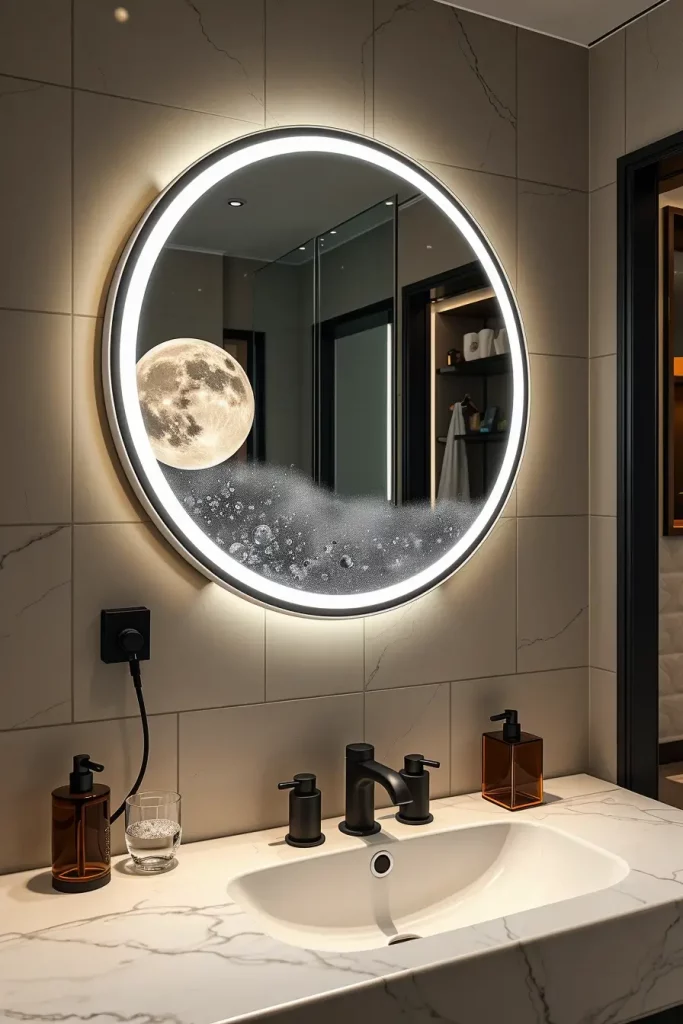
I bring in matte black towel hooks, charcoal Turkish towels, smoked glass soap dispensers and a pedestal with a faux raven. Waterproof LED strips behind the vanity splashback add depth, and a low-profile floor fogger (placed safely away from traffic) delivers a rolling mist for parties.
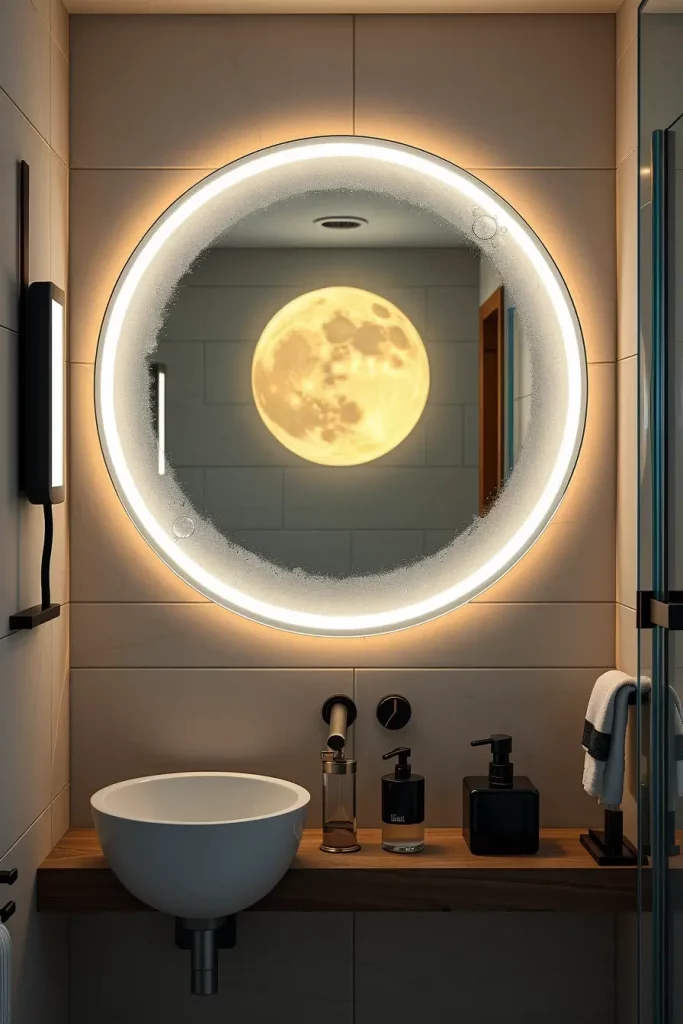
As practice shows, safety and humidity control is everything- bathroom tech should be IP-rated. Electricians and designers always recommend that open-flame candles should be avoided in this case, and I use high-quality flicker LEDs.
What I would include: an ambient sound loop of dripping caves and distant wind played on a waterproof Bluetooth speaker that is hidden in a cabinet. It is insanely successful with low budget.
Kids’ Rooms That Are Cute-Not-Creepy: Safe, Soft, And Playful Spooks
In the case of kids, I create using adorable, touchable and low-contrast color schemes pumpkin orange, lavender, sage and cream. Felt bats, plush ghosts, glow-in-the-dark stars and paper lanterns are my faves. I do not use horror imagery and instead use friendly monster shapes and smiling pumpkins. Nightlights are the primary 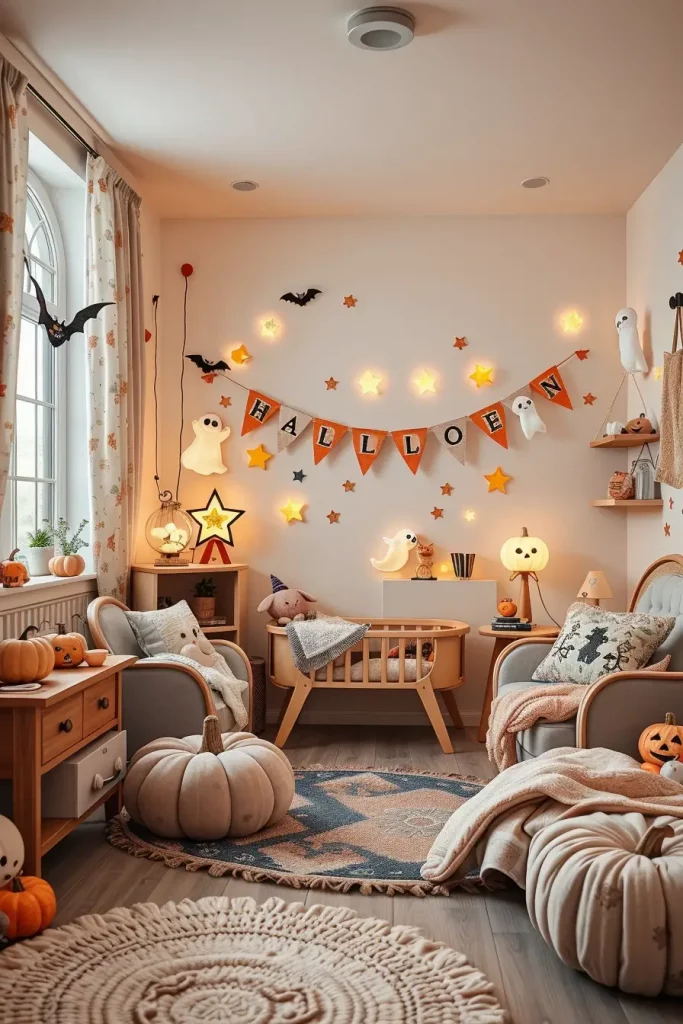
I usually order soft wall decals, fabric bunting, plush storage baskets in the shape of cauldrons, rounded-edge furniture, and no hanging cords. UV is not required in this case, glow paints, and safe plug-in fairy lights are sufficient.
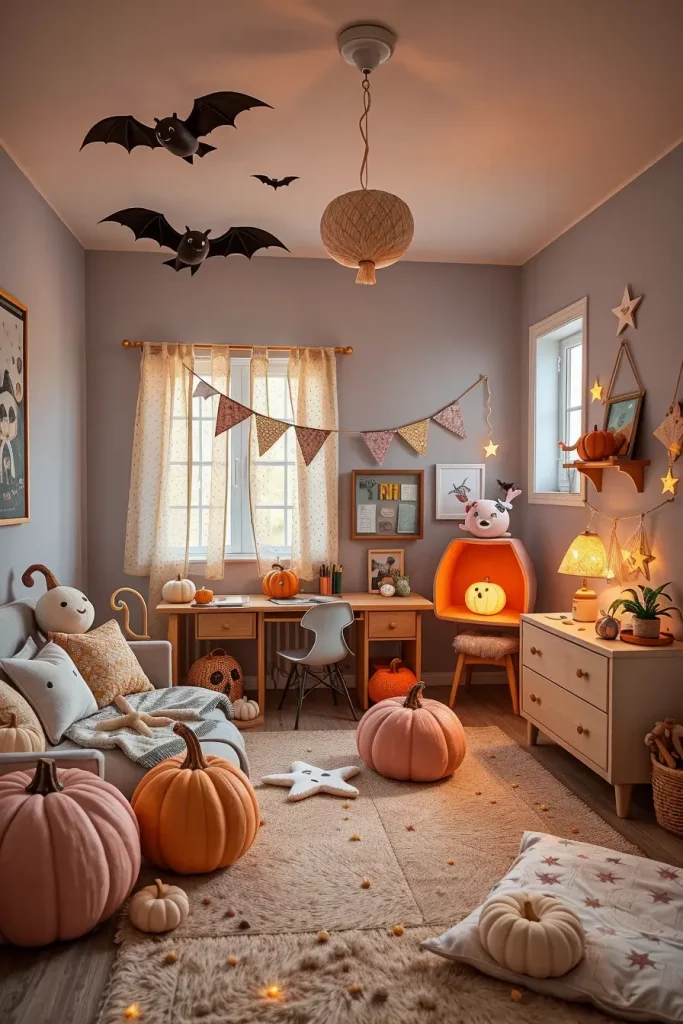
The recommendation of child psychologists to avoid overstimulation at bedtime fits perfectly in my practice as well: cute-not-creepy. I employ low-lumen lights, repeatable shapes, and calm tones that will not raise alertness.
What I would supplement: a simple DIY craft wall- magnetic or cork- that they can change out the artwork seasonally. That provides possession without lasting decorative exhaustion.
Teen TikTok-Worthy Setups: Neon, UV, And Projection-Ready Walls
In the case of teens, I create TikTok worthy corners using UV, neon, reactive paint markers, and projection-ready matte walls. The atmosphere: cyber-goth haunted laboratory with LED pixel strips to music. A projector can be used to display haunted animations looping behind a desk or bed to be shared as much as possible.
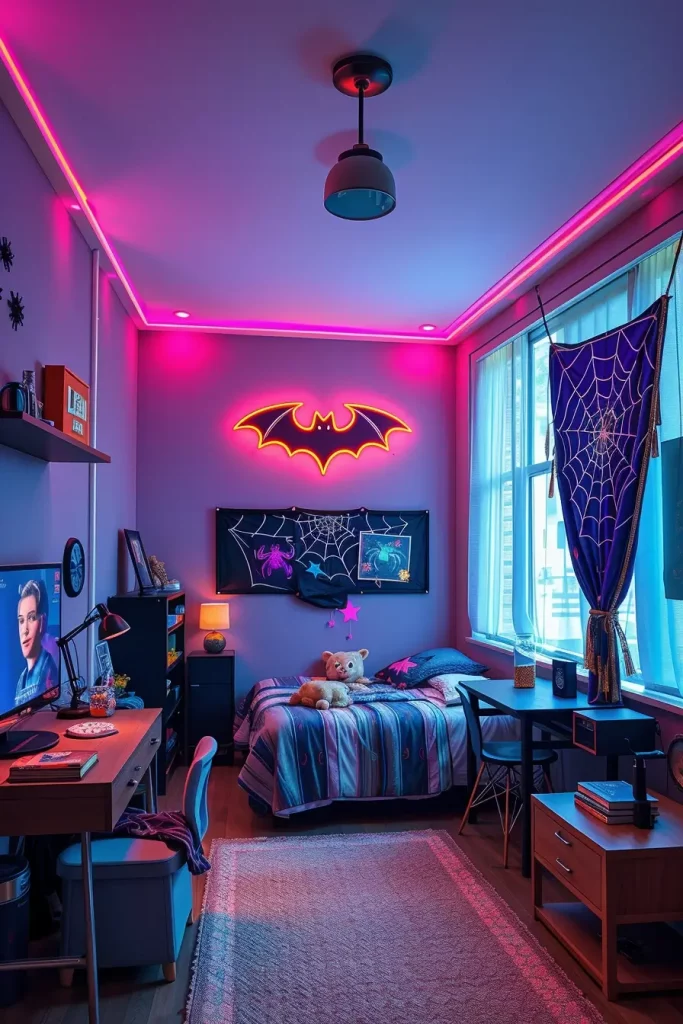
I recommend modular grid panels for props, app-controlled neon signs (words, bats, or crescent moons), reactive spiderweb tapestries, and a secondary, color-neutral backdrop for content filming. The vibe is finished with desk lamps that have RGB ring heads and dynamic LED ropes along the bed frame.
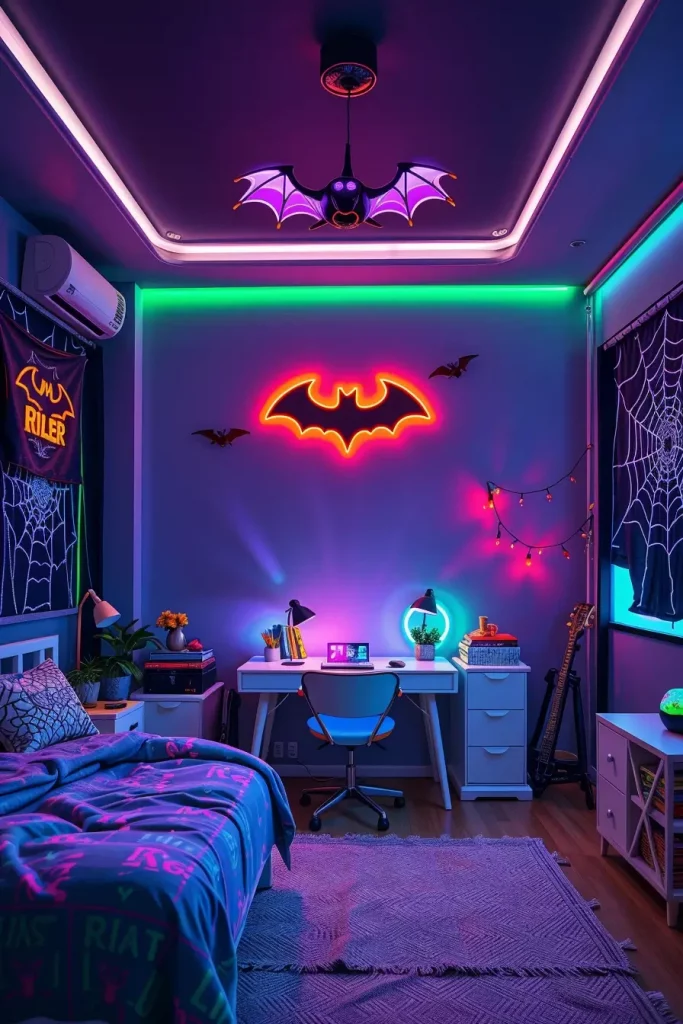
My opinion: provide adolescents with manageable areas. They are fond of switching scenes at a rapid rate to get content, so I set to default presets named Study, Haunt, and Party. This is in line with the argument of digital-native designers: smooth scene transitions.
What I’d add: a ceiling-mounted laser star projector (low brightness), plus a small DMX controller for future expansion—teens will tweak endlessly.
Dorm Room Haunts On A Budget: Micro-Spaces, Max Impact
The most important thing when I am decorating dorm rooms during Halloween is to use small, non-destructive, and very visual ideas. Most dorms have very strict regulations on glue and hardware, so I use removable decals, over-the-door hooks, and portable light. A great trick is to create a “feature zone” over the bed or desk using a fabric tapestry with a spooky pattern, framed with LED lighting strips. These arrangements are cheap, reusable and punchy even in small spaces.
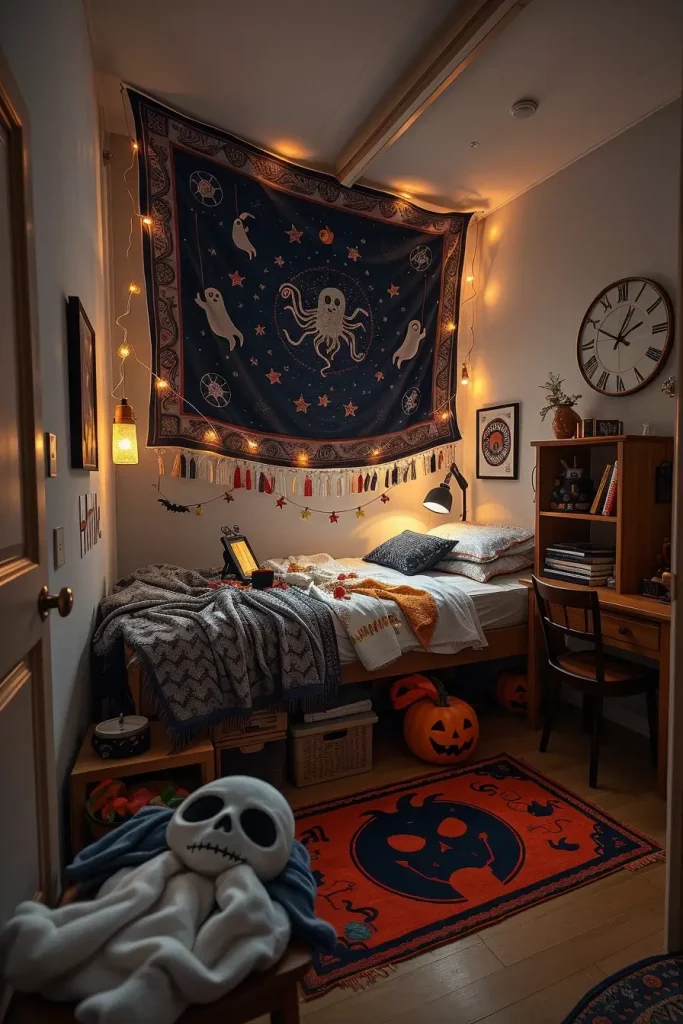
As furniture and decor, I would recommend foldable storage ottomans with a Halloween-themed fabric, battery-operated string lights, peel and stick mirrors with a bat silhouette, and a small hanging cauldron planter. A star or moon printed roll-up blackout curtain can be used as a decorative element as well as to control the light. Color change settings in clip-on gooseneck lamps enable the user to have functional lighting that can be used to enhance moods.
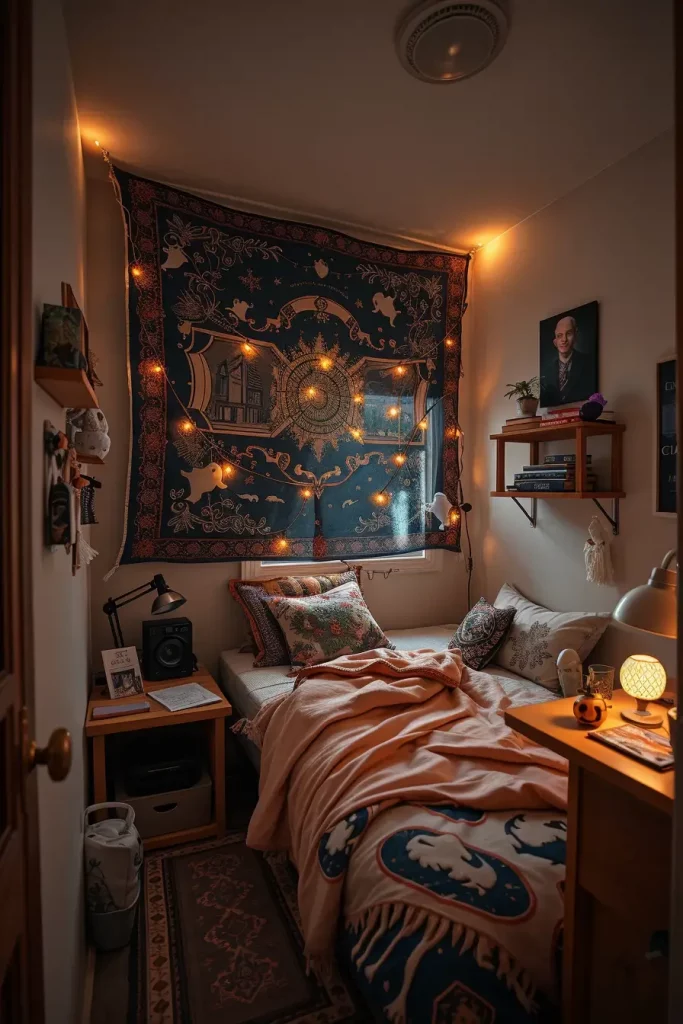
When I worked with college students, they liked multi-purpose items and portable arrangements. Apartment Therapy designers also point out that micro living does not imply micro style so I recommend big prints on soft goods and clever lighting in layered heights to create the illusion of depth.
What is usually lacking? Sound. I suggest a Bluetooth speaker that can be concealed in a fake spellbook or storage cube, music and ambient sound effects can provide a completely different level of immersion without the clutter.
Home Office Haunt-Tech: Zoom-Ready Backgrounds And Smart Lighting
The idea of designing a Halloween home office in 2025 is to strike a balance between professionalism and personality. I adore creating a Zoom-compatible vignette behind the desk: tiered backdrops, smart light bulbs in the bookcase, and some Halloween decorations such as a flickering lamp in the shape of a lantern or a bat silhouette wall light. It is all about that single curated angle that looks festive, not frantic.
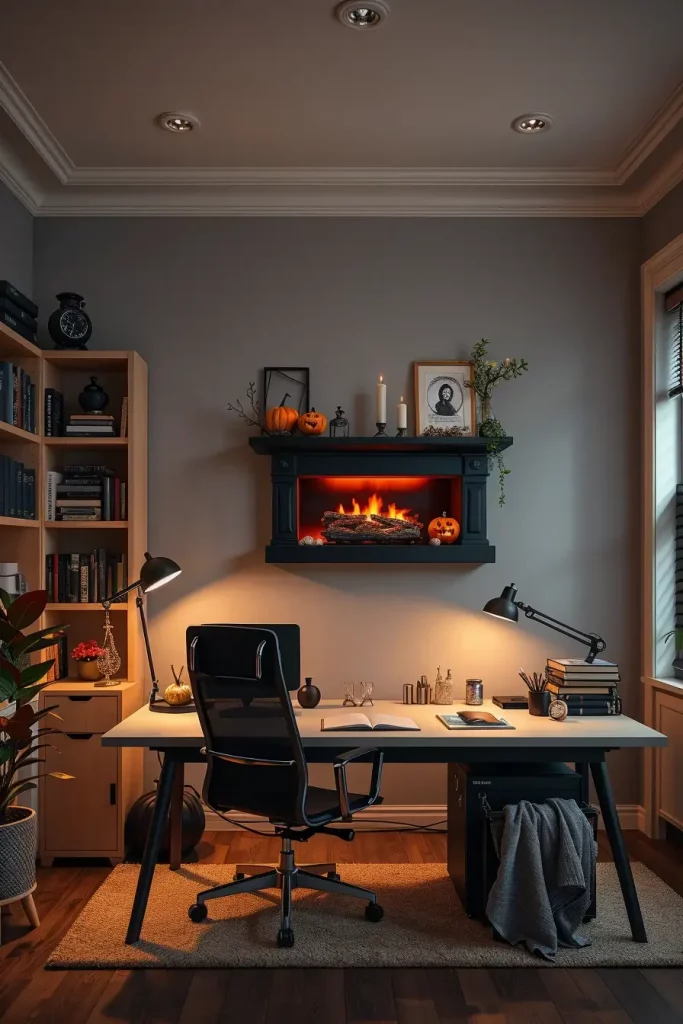
On the furniture side, I am going towards charcoal fabrics on ergonomic chairs, matte black desk organizers, and a small faux mantle on the wall as a staging area to be used as a fireplace with books, LED candles, and a skeleton bust. Oxblood or moss green desk mats are warm and not too far out of your professional palette.
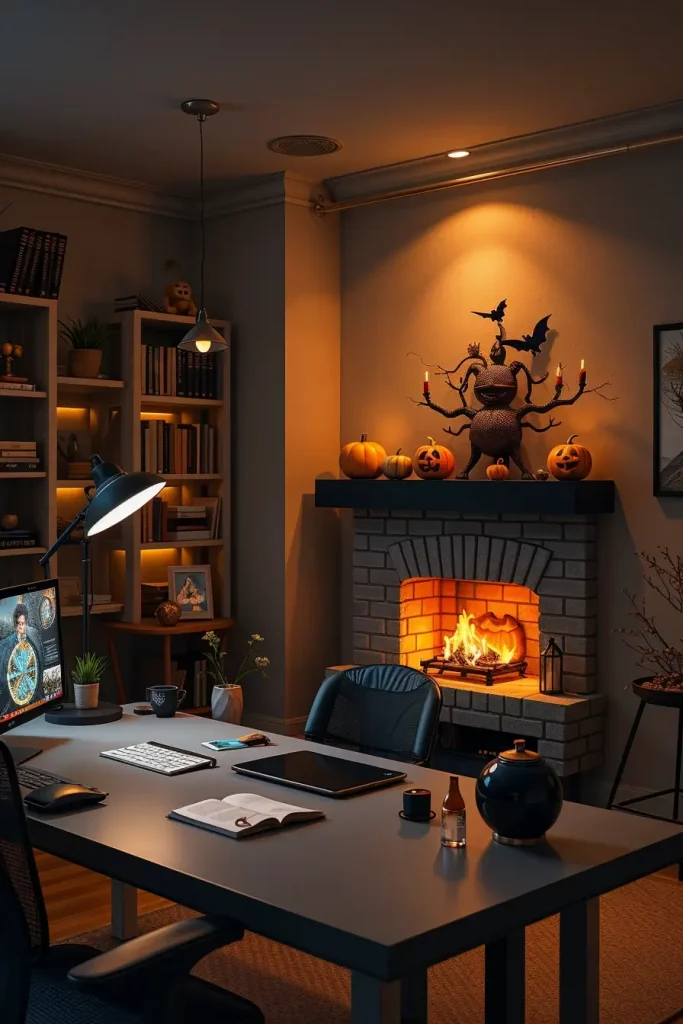
My customers are also demanding more and more configurations that switch between work and after hours. I design two lighting scenes: one cool and clear to make video calls and another warm, low, and moody to enjoy Halloween evenings. This strategy is also being repeated by design thought leaders on LinkedIn and Work Design Magazine, who emphasize the importance of hybrid workspaces being flexible and personality-based.
I would also say: involve the vertical space. Magnetic Halloween items can be easily updated by using wall-mounted faux bookcases that do not consume space on the floor.
Mantel Of Macabre: Fireplace Focus Points With Layered Styling
The fireplace is a center piece and in Halloween decoration, it is the altar. I decorate it in layers: gauze fabric over the mantel, piles of old books, LED candles in sets of three, and a large mirror or oval frame with a cling decal of a ghostly person. The objective is dimensionality, height, width and texture.
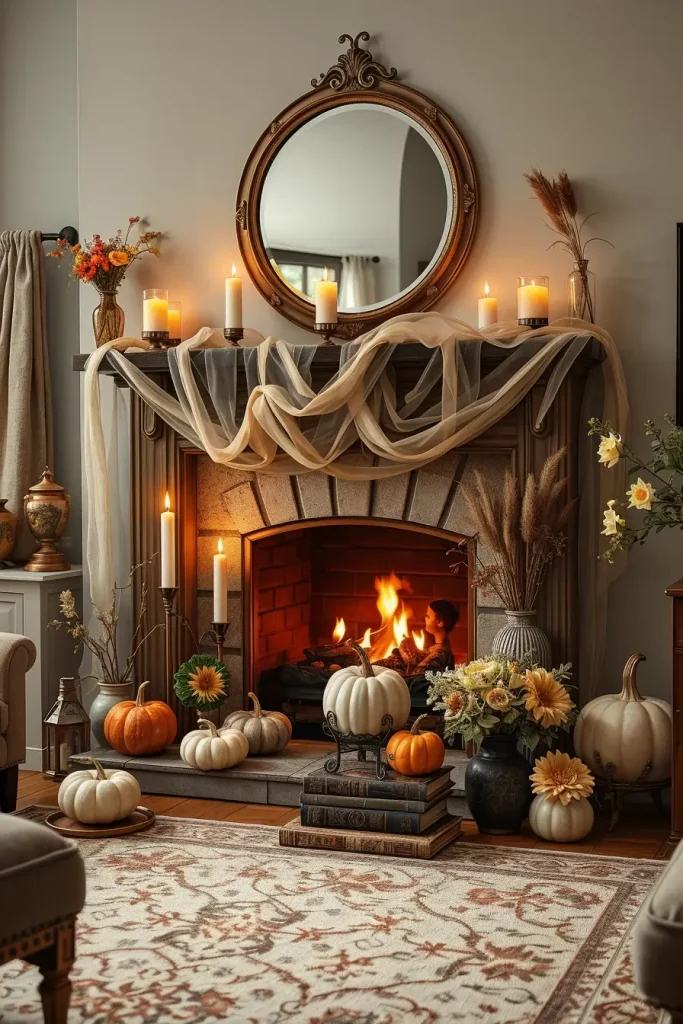
My decorations include matte-finished ceramic pumpkins, antique-looking lanterns, dried flowers in black or burgundy, and string lights that can be strung under the gauze and glow like embers. When there is a TV above the mantel, I put looping fire images or storm images to make a complete sensory picture.
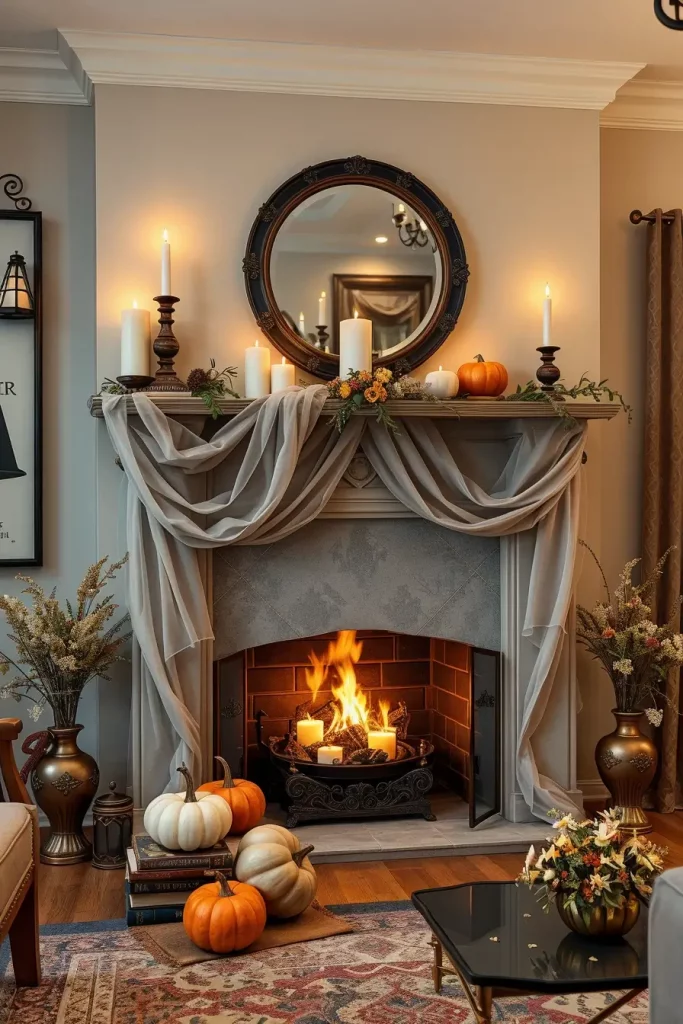
Having been in the business of renovating old houses and new construction, I have discovered that the fireplace area is a place where a bit of clutter is welcome. You do not require 50 skulls, a couple of well-placed high-contrast items are sufficient. According to the experts of Architectural Digest, it is better to be symmetrical and different: put anchor items at both ends, but use different texture and material in the middle. I use such a strategy here.
Missing element? I would include a sound effect loop that would be synchronized with smart speakers concealed in the log basket- low wind, distant whispers, and crackling fire that would make a complete vignette.
Windows, Silhouettes, And Projections: Storytelling From The Street
Windows are the place where your Halloween room decor links with the world. I always suggest window silhouette kits, or static clings, or translucent fabrics with back lighting to make storybook scenes that can be seen in the street. By 2025, it is easier to find smart projectors that can show animated ghosts, witches, or flickering candlelight and mount them in the windows of apartments.

I put up gauzy curtains with cut-outs, put up battery-powered window candles, and hang mobiles of floating ghosts on fishing line and ceiling hooks. Semi-sheer drapes or projection film admit the light, but conceal the projector. It is the outside-in aspect of storytelling that makes this design decision particularly satisfying.
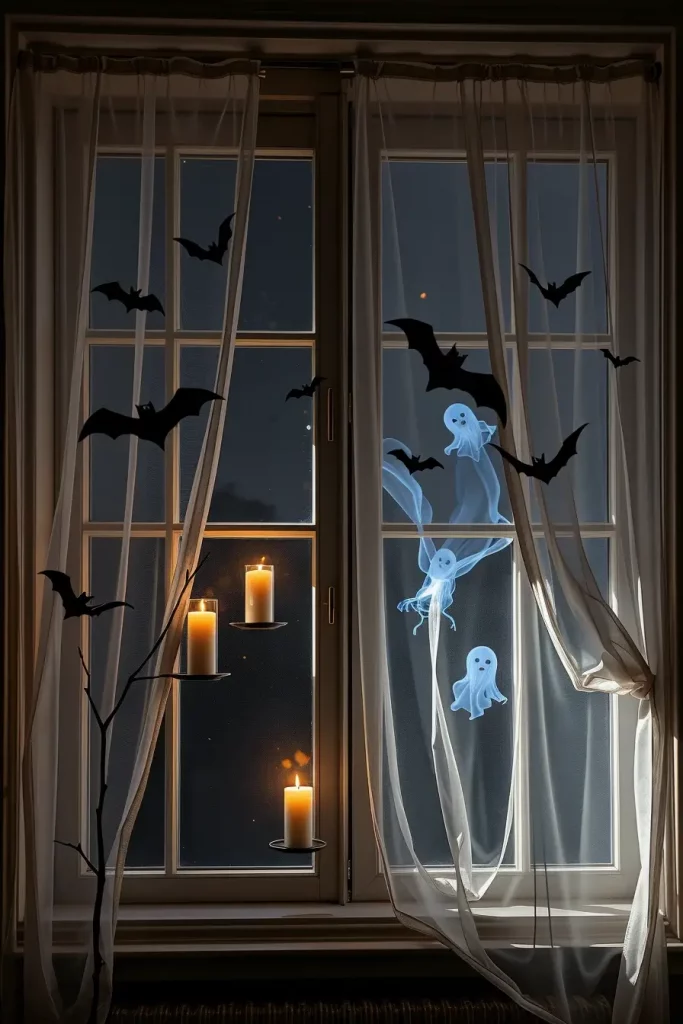
I believe that window treatments are underestimated in holiday design personally. They are the billboard of your house and they are reusable every year. The influence of strategic lighting and movement in and out, the HGTV designers refer to it as cinematic, welcoming, and ideal in neighborhoods with high foot traffic.
Missing here? The window had a QR code that connected to a Halloween playlist or soundscape. It is interactive and contemporary- and it earns you extra points with the trick-or-treaters.
Hallway Of Horrors: Transitional Spaces With Maximum Drama
Hallways are busy areas and I enjoy making them dramatic passageways. Imagine small spooky hallways: black cloth hanging down on the ceiling, intelligent LED lighting on the floor moldings, and movement sensors that activate flickering sconces or creepy noises. Here you make atmosphere between rooms.
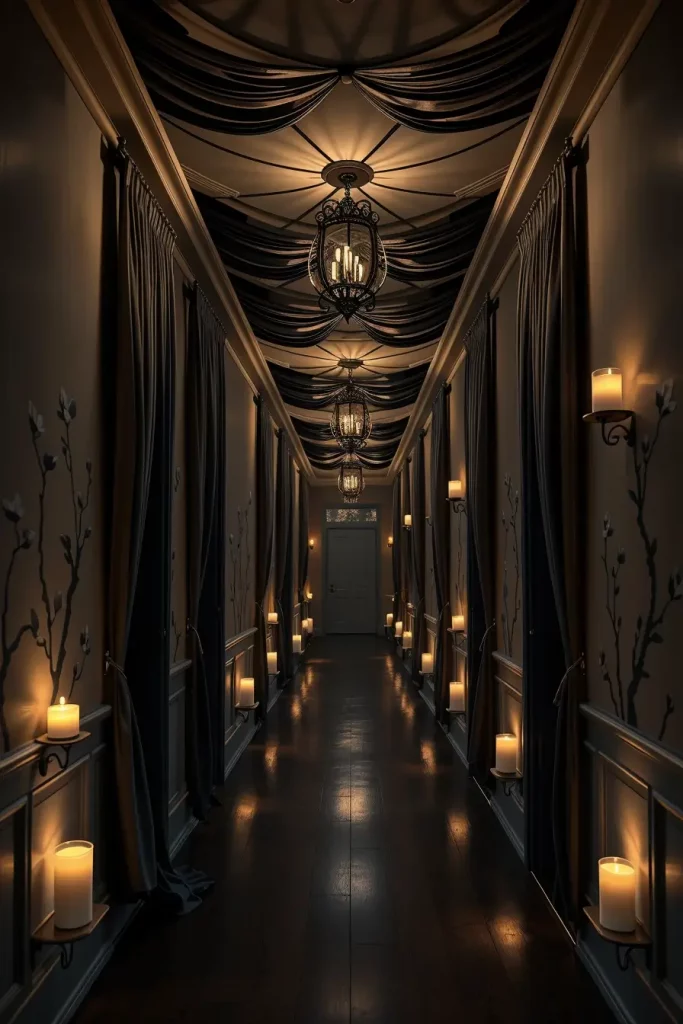
I use wall decals (like reaching hands), thin fabric partitions, haunted mirror clings, and tension rods to hold lightweight drapery without nails. Deep reds or blacks in a runner rug will create drama and absorb sound. Floating candles (LED on fishing wire) provide a magical Harry Potter-style overhead illusion.
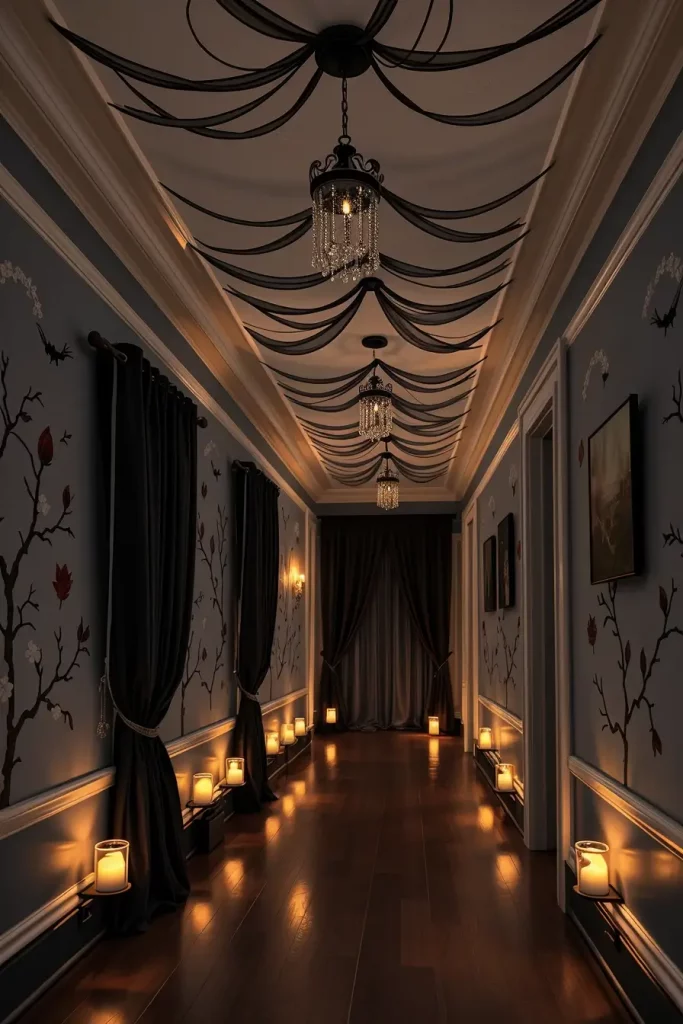
In my previous projects, I have observed that the decor of the hallways usually becomes the favorite of the guests. Domino and Dwell magazine designers recommend approaching transitional spaces as a threshold: a liminal moment, when mood is at its peak. I totally concur and employ dramatic contrast of the main rooms.
To make this better: add scent once more. A cedar, clove, or smoke essential oil diffuser in a cubby can be used to produce that smell, with the flicker of lights to give that creepy, atmospheric effect.
Entryway First-Impression Frights: Doorways, Doormats, And Dramatic Lighting
Your foyer makes the statement. I start with layered doormats (“Welcome” atop “You Dare Enter”), LED step lights on the riser edges, and fog creeping from a corner planter. Lighting is the most important part of it- uplights on both sides of the door, preferably color-changing and timed.
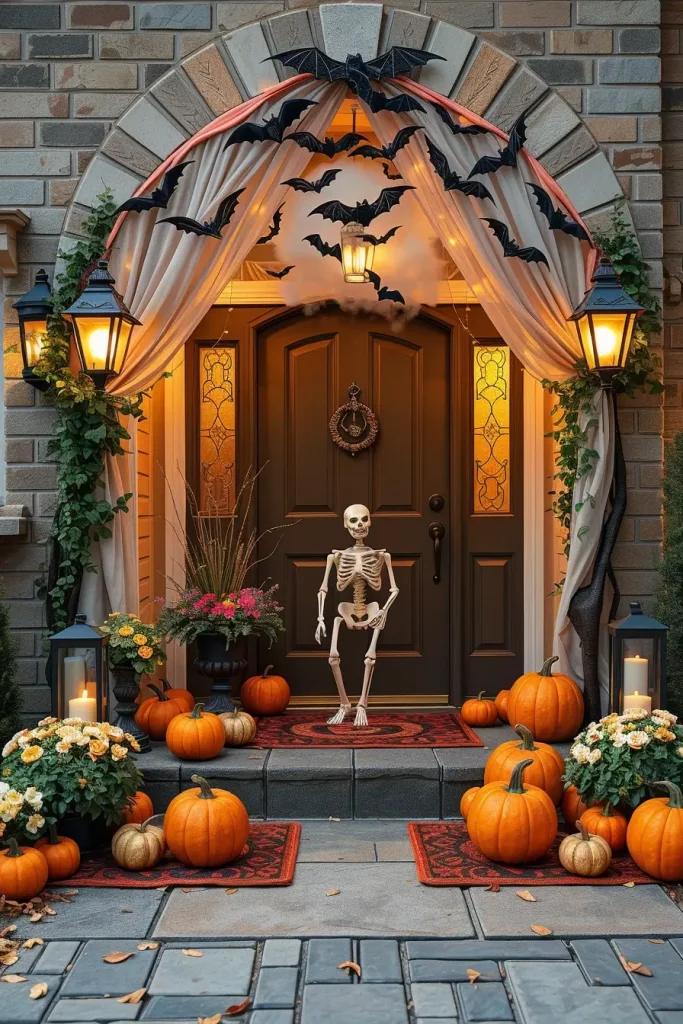
I construct a vignette using fake pumpkins, a skeleton in a chair or swing and a sign post directing to cemetery or beware. I hang foam bats or glowing orbs and cover the overhead with fabric. A motion-activated doorbell sound (creaking, howling) is cheap but super effective.
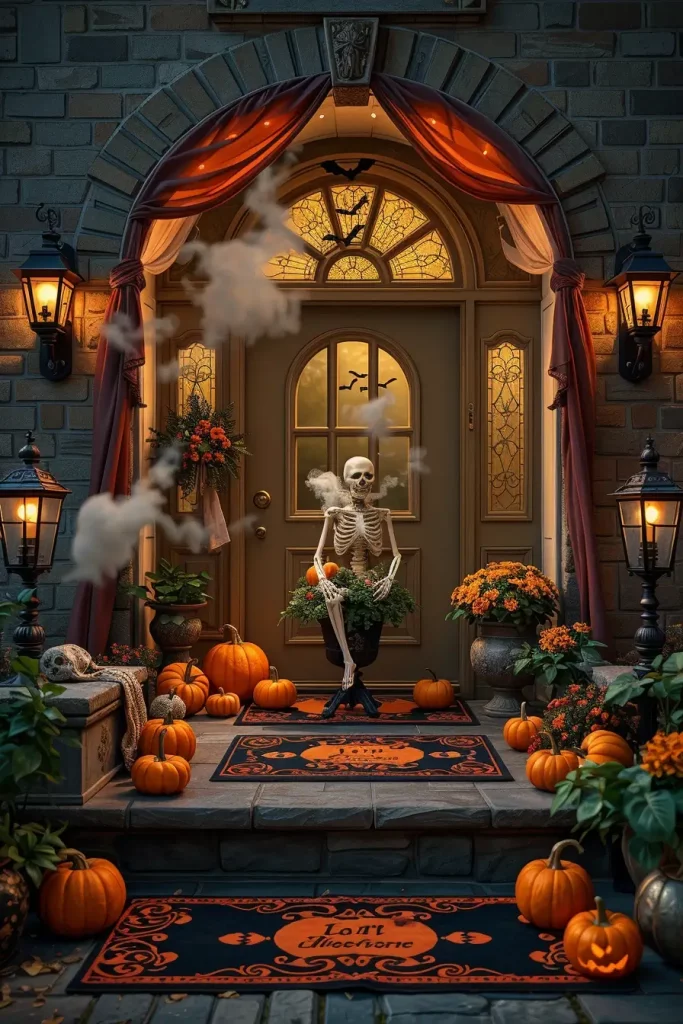
I am personally fond of this aspect of Halloween design, it is dramatic and it makes people excited. Design experts at Better Homes and Gardens never stop stressing the importance of first impressions, and I take that to heart here by focusing on eye level lighting and staging.
What would be better about this arrangement? Install house numbers that are blackened steel with backlit LED to direct visitors, and to add to your chic persona without losing the creep.
Smart LED Sorcery: Dynamic, App-Controlled Color Scenes And Effects
Lastly, there is intelligent lighting that connects it all. I have app-controlled strips and bulbs that have pre-set scenes called Witchs Brew, Haunted Blue, and Hellfire. You can activate them through Alexa, Google or on your phone. It is all about coordination: the hallway, the living room, the outside all moving in sync.
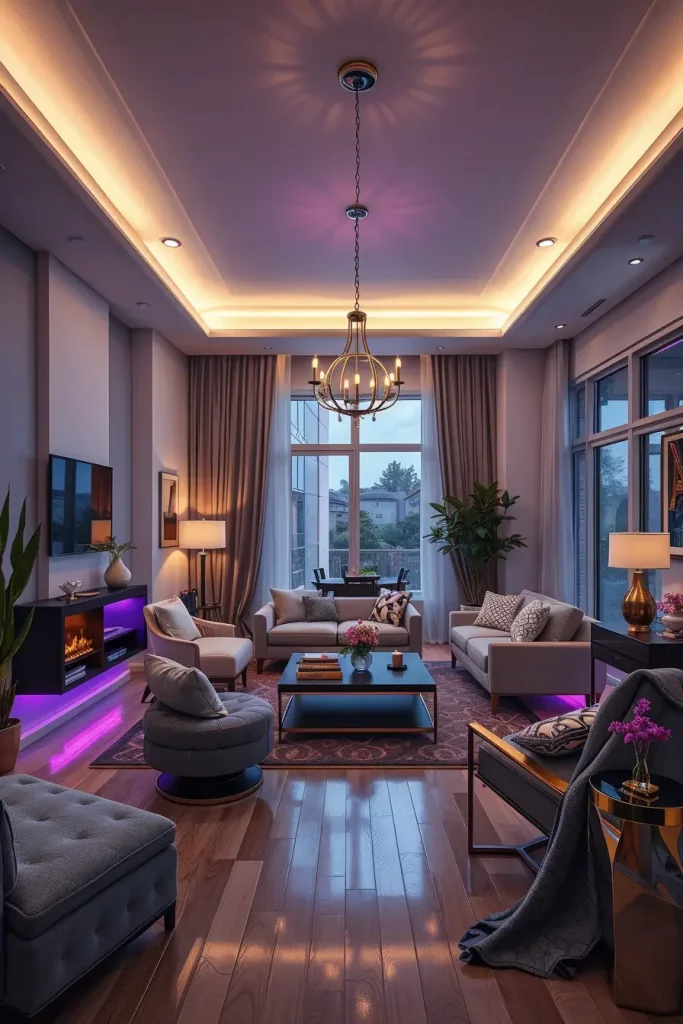
I put pixel LEDs behind furniture, rope lights under baseboards, and put in diffusers to achieve a smooth gradient appearance. It is a huge advantage: scenes may flow between rooms, creating a visual narrative. Moonlight in the bedroom, Firelight in the kitchen, Blood Moon on the porch.
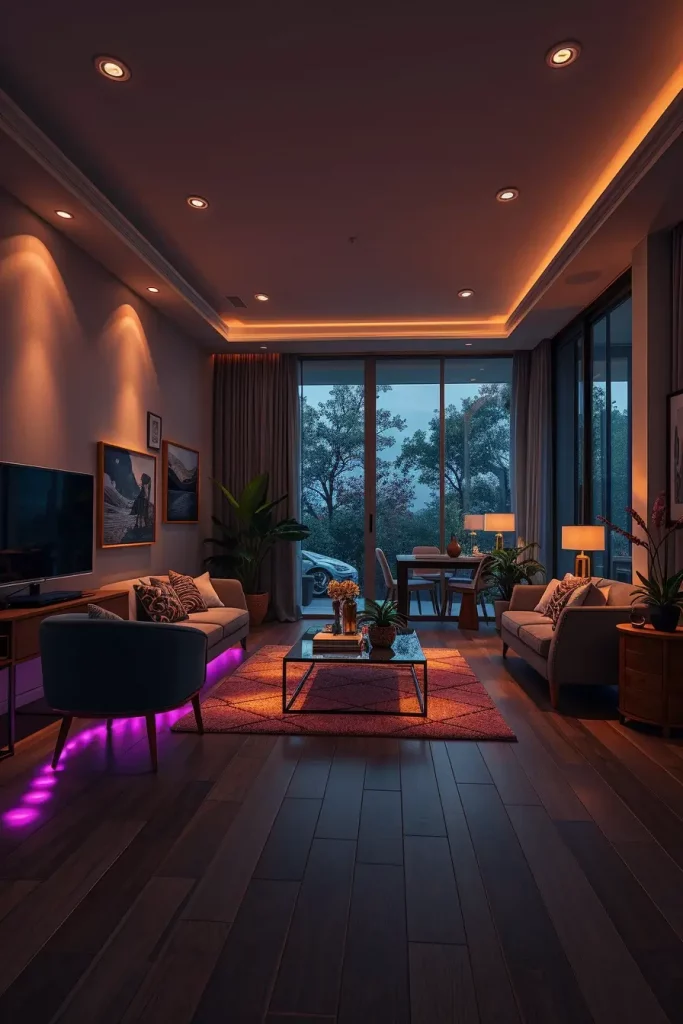
I am aware of the fact that lighting is where the magic resides, based on my experience working with tech-savvy clients. Both Digital Trends and Wired magazine have predicted that in the future, lighting design will be the next big thing in holiday decor, and I am already witnessing it. When the whole room is filled with the light of the story, there is no use of props.
To make this even better? Install Halloween sound boards or interactive wall switches with motion triggered lighting. Scary, intelligent, and fashionable.
3D Wallpapers, Decals, And Murals For Instant Atmosphere
I begin with walls, as they are the most expeditious means of transforming a so-called ordinary room into a movie-set. By 2025, depth, arches, crypts, or infinite corridors can be faked with hyper-real 3D wallpaper or peel-and-stick decals without leaving a construction mess. I enjoy trompe l oeil brick vaulting behind a couch, or a dark staircase mural at the end of a hall, it is renter friendly, easy to put up, and provides the most drama with the least amount of work, ideal for a modern Halloween decor.
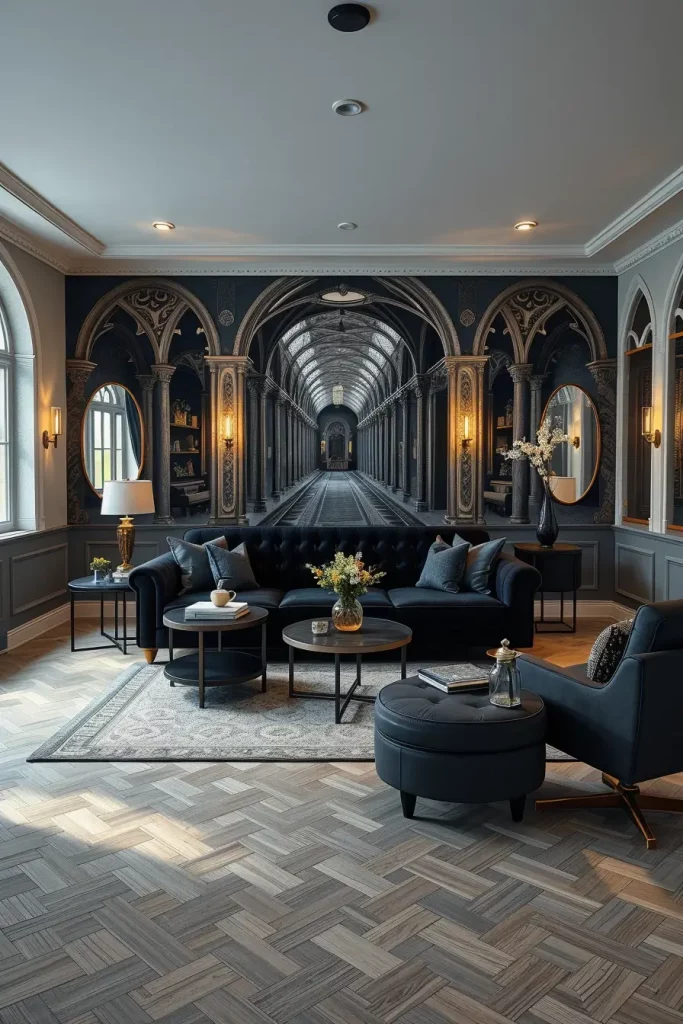
For furniture and decor, I pair these murals with low, dark seating (charcoal boucle or velvet), matte‑black accent tables, and up‑lighting at the baseboards to exaggerate the illusion. The wall is anchored by a narrow console beneath the mural and arched mirrors carry the faux depth further. I will also install dimmable smart bulbs to be able to adjust the mood of the mural between creepy dusk and neon-UV glow.
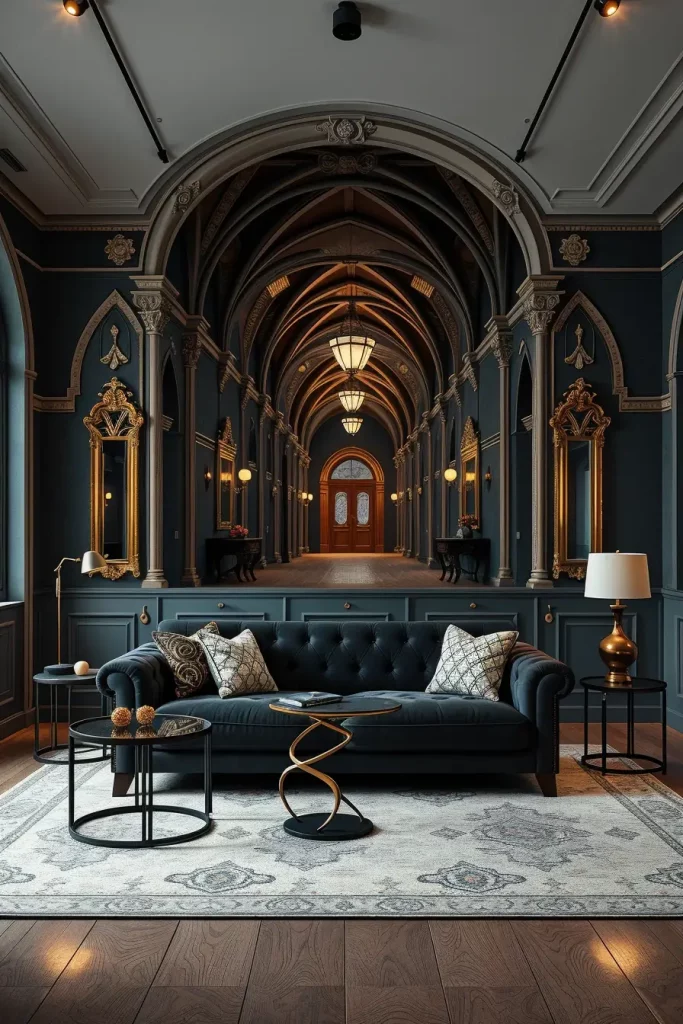
As practice has shown, the fewer objects are around a trompe l oeil wall, the more plausible the trick will be. A well-known tip from set decorators (and echoed by Architectural Digest pros regularly): light the edges of the illusion to sell depth—so I run a thin LED strip along the mural’s “horizon line.”
What I would still include: discrete projection mapping. A mini pico projector will suffice to provide flickering candlelight or drifting fog over the mural, and drive the illusion into motion without additional props.
Sustainable And Reusable Halloween Decor: Thrifted, Modular, And Low-Waste
I take sustainable Halloween decorations as a modular system that I can re-theme each year. Vintage candlesticks are spray painted matte-black, old amber bottles are turned into potion props, and scraps of fabric are turned into banners or curtain ties. I plan with neutral foundations: black linen tablecloths, raw wood risers, smoked glass, so I do not have to repurchase the main decor every year.
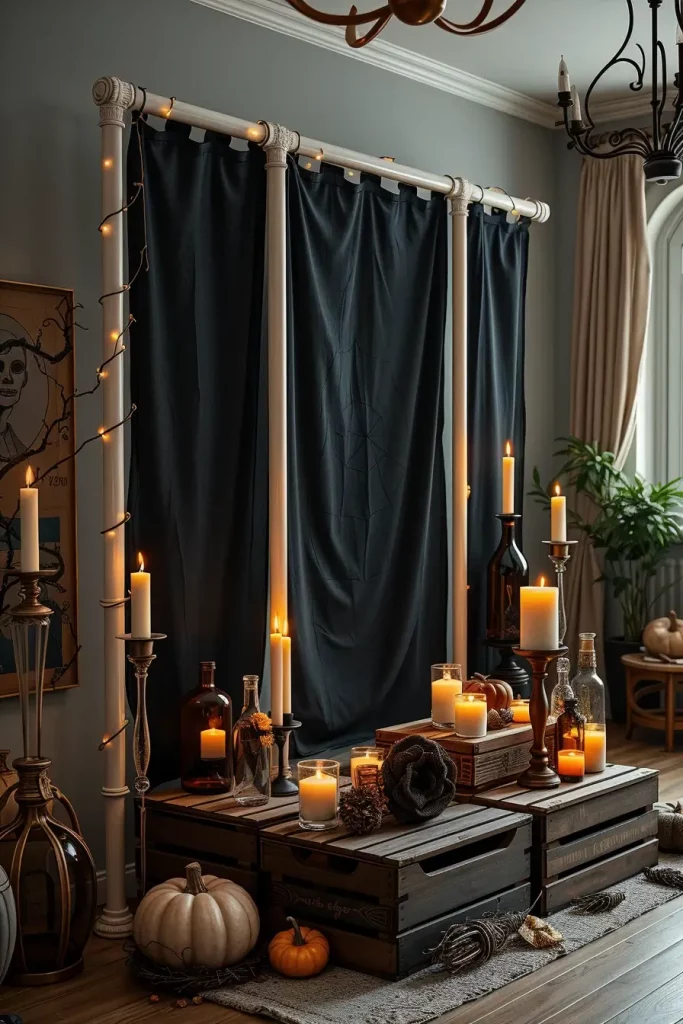
Each element does a job: stackable crates serve as risers and storage; modular PVC pipe frames support fabric walls I can re-cover each October; rechargeable tea lights eliminate batteries and waste. I have a labeled tote that has cables, clamps, and reusable hooks, so my setup time goes through the floor.
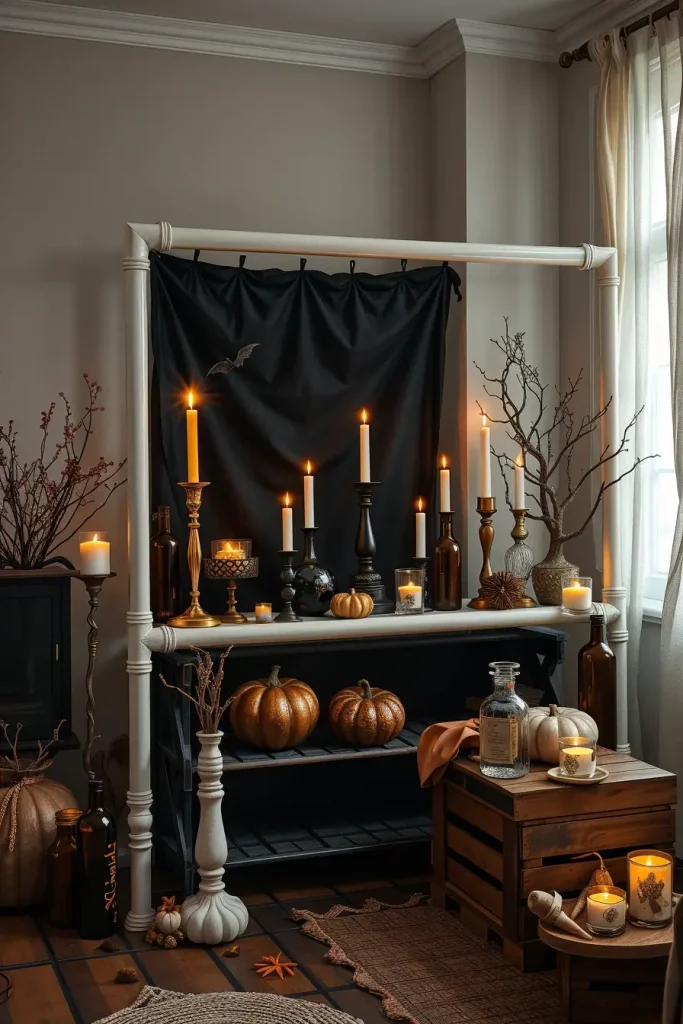
Professionally, I’ve found that following “buy once, style forever” (a mantra I hear from US stylists across House Beautiful and HGTV Magazine) saves money and reduces landfill waste. It is also simpler to create an annual recognizable personal aesthetic.
What I’d still add: a tiny repair/paint kit in the storage bin (flat black, matte bone-white, contact cement). A night of touch-up brings everything back to life.
DIY Dollar-Store Hacks That Look Designer
The challenge is my favorite: I am going to use DIY Halloween decorations found at the dollar store and make it look expensive. In 2025, I spray‑paint my plastic skulls satin ivory, and dry‑brush gray to resemble plaster statuary. Inexpensive frames are covered with rub ‚on ‚buff metallic wax and contain printable haunted portraits. A one dollar plastic chain, beaten with matte charcoal and metallic accents, appears to be cast iron.
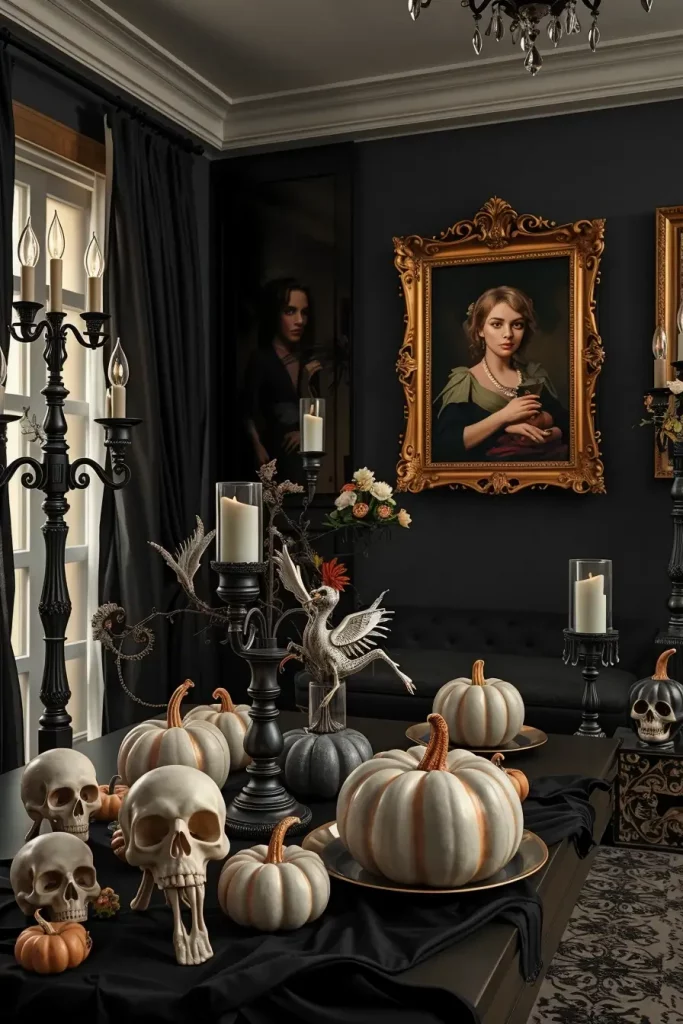
Every item deserves its due: the skulls are used as bookends, with secret weights inside; the plastic pumpkins are given concrete-look texture paste; the cheap candlesticks are glued to secondhand saucers to make the heavy, layered candelabras. I dress in monochrome color tales (black, bone-white, or UV neon) so nothing is accidental.
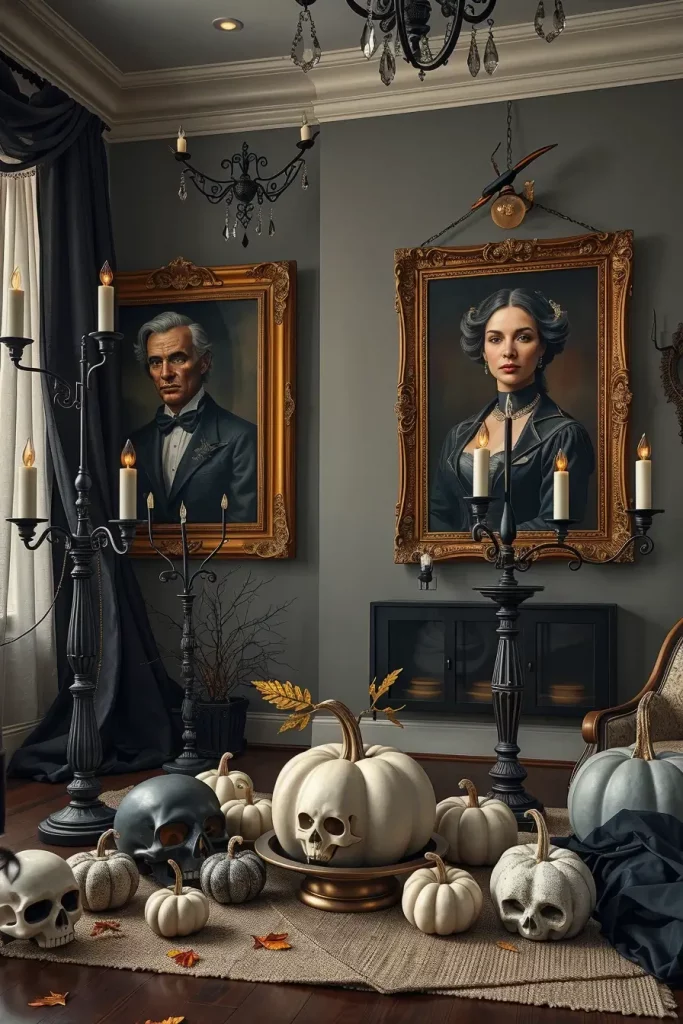
My take: size matters. Larger elements (oversized portraits, tall floor candelabras) immediately feel more expensive. I will always put little dollar-store things on plinths or piles of books to make them look more substantial, an old prop stylist trick.
Piece to add: fabric. One piece of gauzy black chiffon or tulle immediately lifts and unifies all the hacked objects underneath it.
3D-Printed Props, Skulls, And Gothic Fixtures You Can Make At Home
Desktop printers are less expensive and quicker, so 3D-printed props are my secret to making repeatable, accurate accents. I print articulated skeleton hands to use as drawer pulls, custom gothic corbels to use as shelves, and fancy candle sleeves that slide over LED pillars. PLA accepts paint with a gorgeous finish, bone, bronze or oxidized copper finishes are a breeze with layered acrylics.
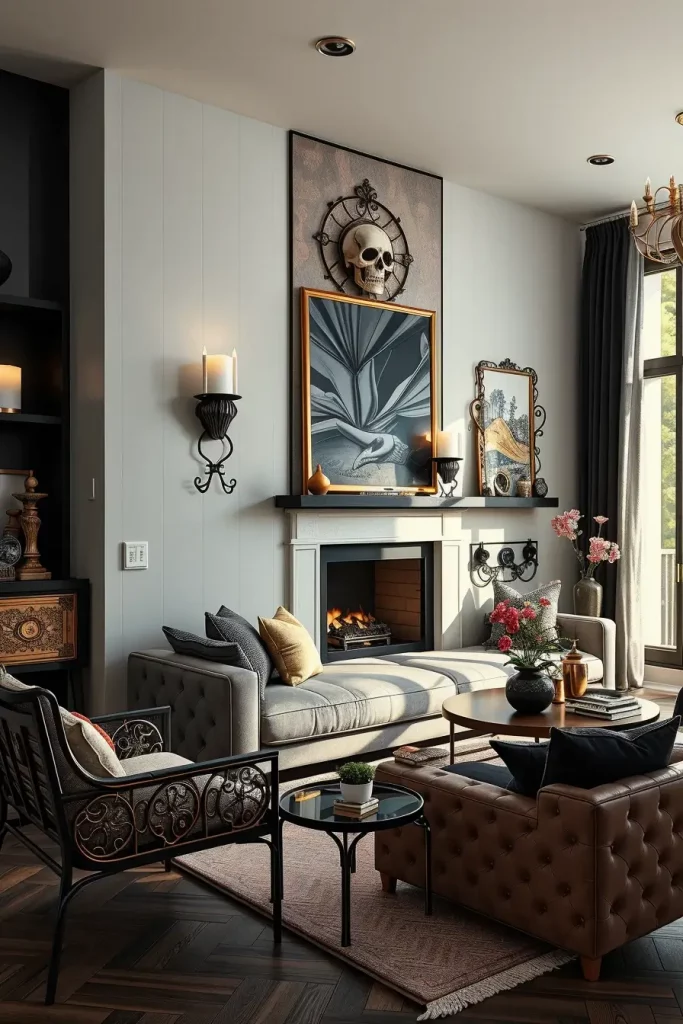
I put functions: 3D skulls with hollowed out insides conceal smart speakers; ribcage sconces hold LED candles; fancy filigree frames clip onto plain IKEA shelves to goth them up. Since the files are repeatable, I will be able to match sets in different rooms without going on a store hunt.
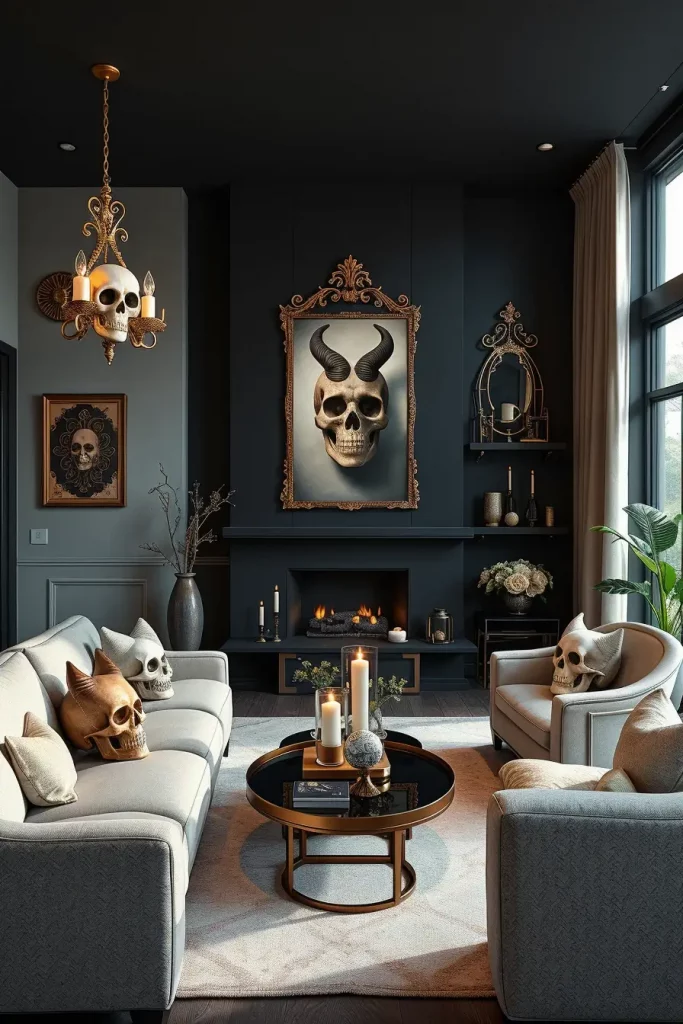
In my experience, prints read as real when they have been sanded + filler primer. Many US makers (I follow a few on YouTube and Reddit’s r/3Dprinting) recommend 220–400 grit sanding plus a filler coat before painting; I absolutely agree—it’s the difference between “toy” and “prop.”
What I would add: shared STL libraries with your friend group. You print the skulls, they print the crows exchange and everyone decorates his house without spending any more money.
AR And VR Haunted Rooms: Interactive Illusions For Parties And Kids
I’m leaning into tech-forward Halloween room decor this year with AR filters mapped to the room’s walls (via phones/tablets) and light VR experiences for party “side quests.” Children can use their devices and watch ghostly figures crawl up the ceiling, and adults can use a brief VR storyline to escape the crypt sitting on the sofa.

Core components: a clean, minimal physical set (dark drapes, a few key props as markers), decent Wi-Fi, and mounted QR codes that trigger AR scenes. I maintain a safe and clear room, wire management is essential, so no one can trip with a headset on.
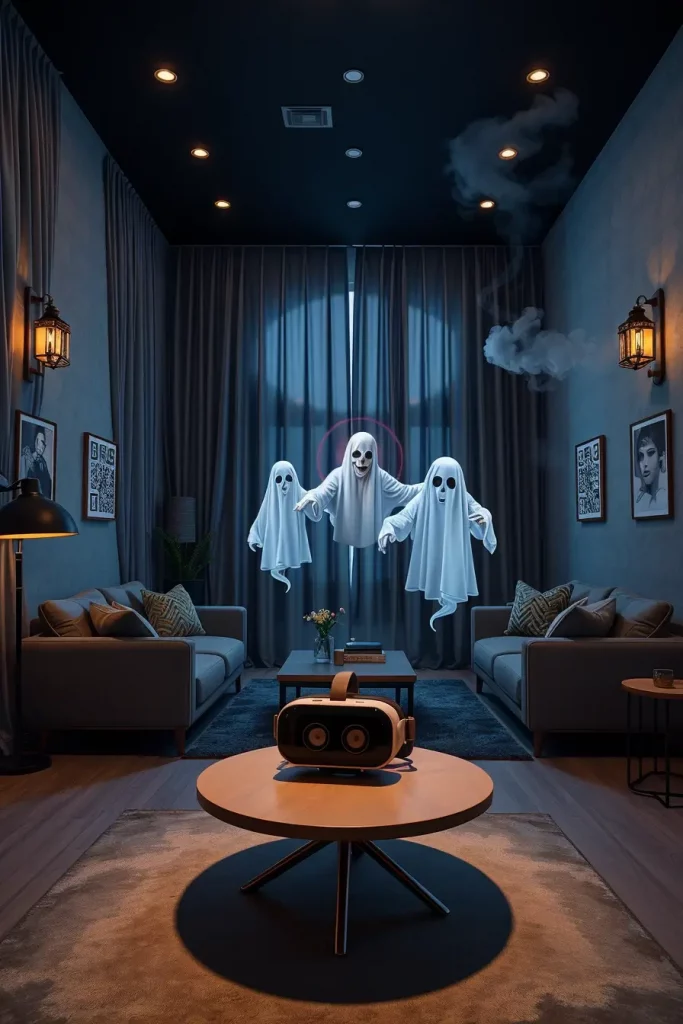
My opinion: technology is a people pleaser, but it should not be used as a substitute to design. I continue to add physical effects, such as foggers, cold air blasts using a mini fan, so that the virtual horror is anchored in the real world.
What I’d add: a “no-tech” fallback loop (projected haunted portraits on the wall) for guests who don’t want to use devices. Participation should never be the source of atmosphere.
Soundscapes, Haptics, And Scent Machines: Multi-Sensory Fright Design
To get off the visuals, I create a multi-sensory profile: directional speakers are muttering along the corridor, a low-frequency hum beneath the sofa creates tension, and a smart scent diffuser emits whiffs of damp stone or pumpkin-spice crypt on a schedule. Haptic transducers can be fitted under shelves and vibrate props as the footsteps get near.
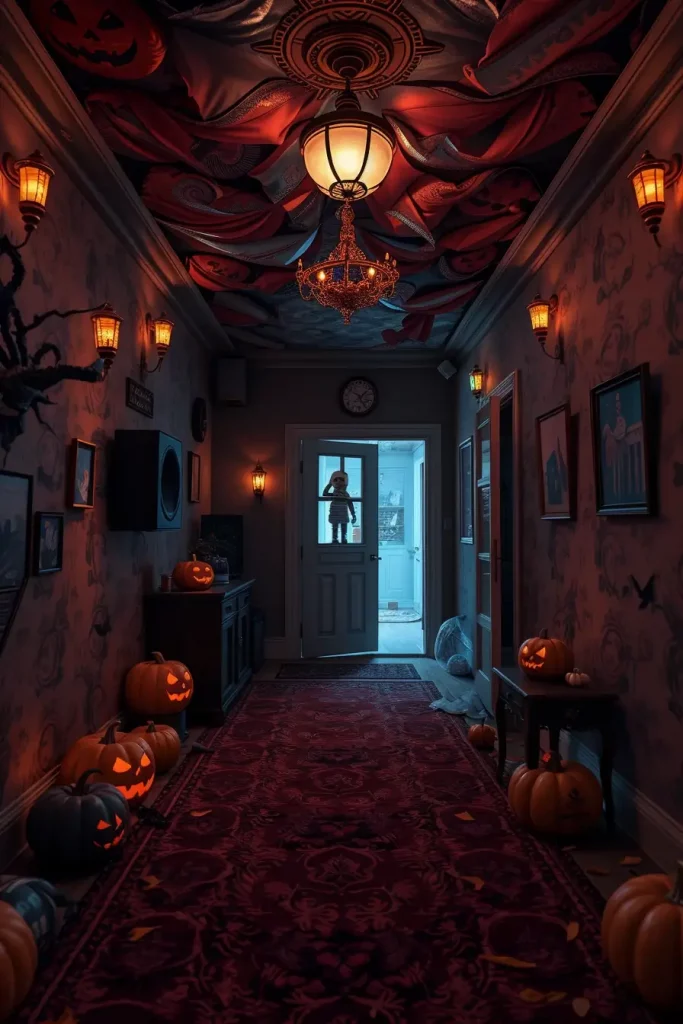
Each device has logic of placement: subwoofers next to structural components to send vibrations; tweeters near the listener to hear whispered words; scent diffusers next to HVAC return vents to spread the scent evenly. I will script scenes- silent build up, shock, warm cooldown- so that guests are entertained.
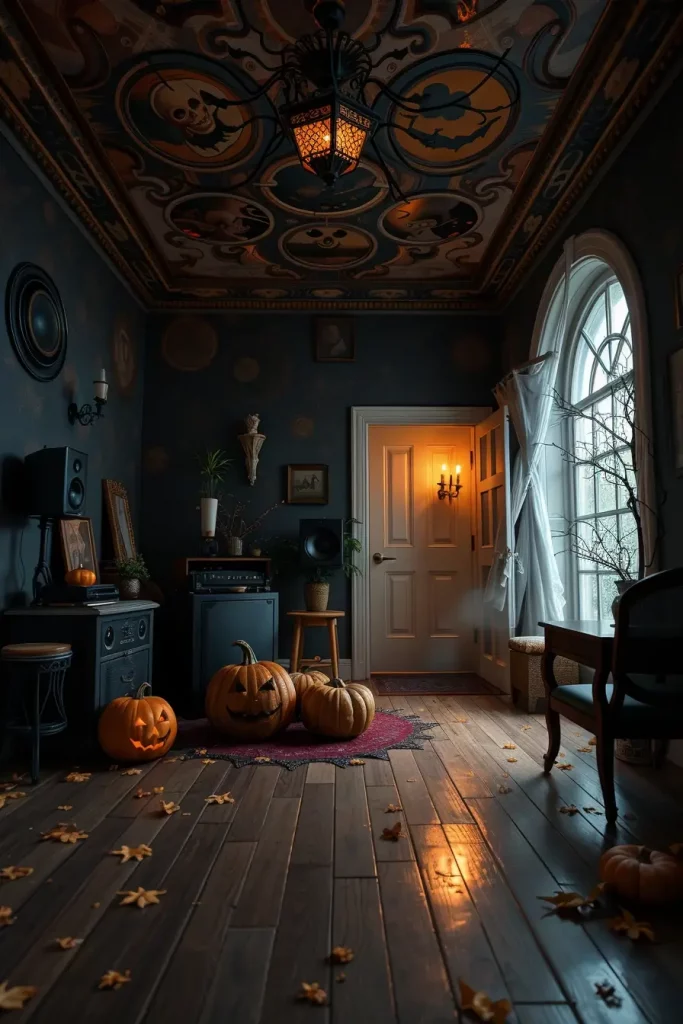
In my career, I have heard hospitality designers state that ambient smell and sound can influence memory more than sight. You are right: visitors never say anything about the precise wallpaper pattern, but about how it felt.
Gap: a convenient quiet zone. Halloween intensity is good fun, yet psychological comfort is important. I always re-set with a softer annex with warm lighting and cinnamon tea.
2025 Color Palettes: Pink Gothic, Emerald Enchant, Monochrome Minimal, And UV Neon
In halloween room decor ideas 2025, color is the expressway to freshness. I’m rotating four palettes this season: Pink Gothic (dusty rose velvet, bone-white skulls, black ironwork), Emerald Enchant (deep greens, brass, mossy textures), Monochrome Minimal (black, white, gray—architectural, gallery-like), and UV Neon (electric purples/greens reacting under blacklight). The same base furniture can be changed into each palette.
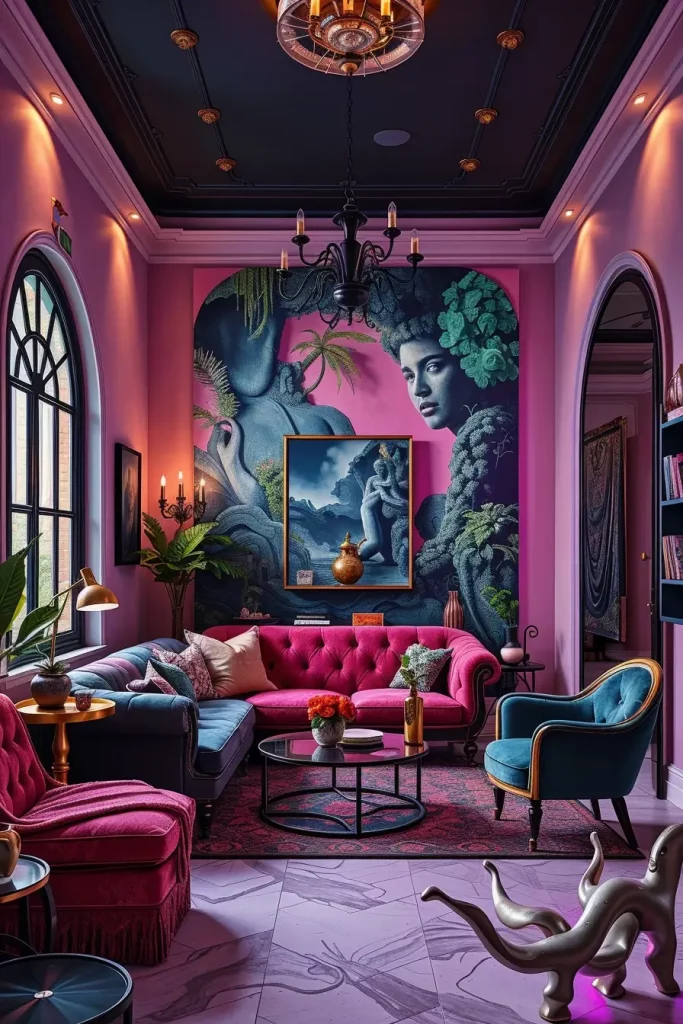
I reduce it to: Pink Gothic adores velvet sofas, baroque frames painted matte black, and rose-tinted glass. Emerald Enchant requests dark wood shelves, apothecary jars and antique brass. Monochrome Minimal employs negative space, matte ceramics and sculptural seating. UV Neon flourishes on acrylic props, reflective films and strip LEDs.
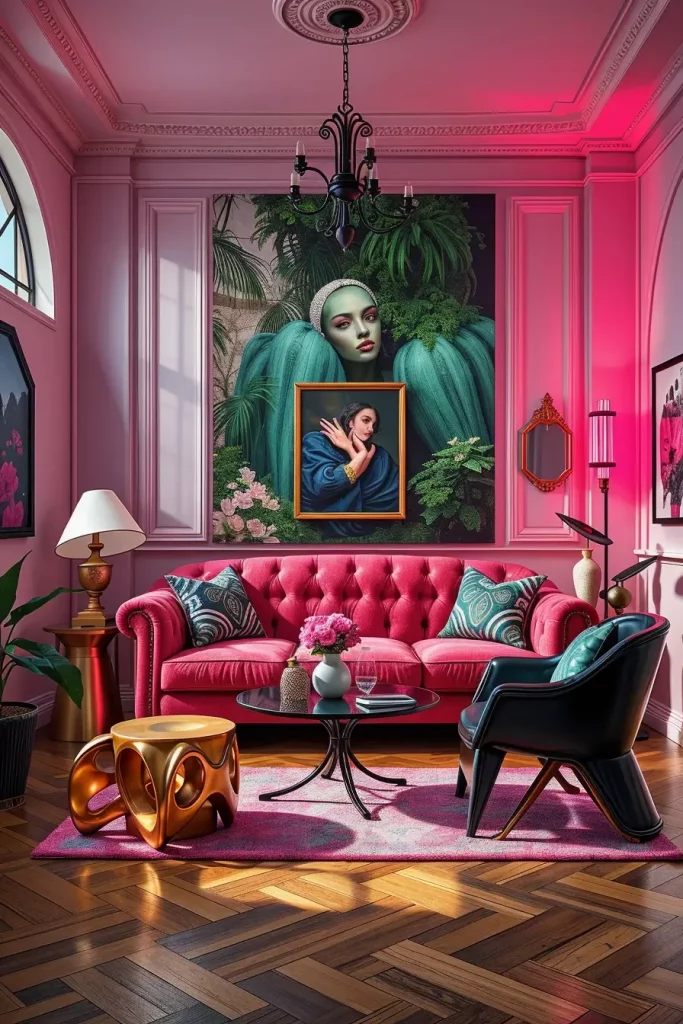
My take: color discipline is what makes a room unified. I restrict each palette to 2-3 prevailing colors and repeat them in textiles, lighting gels, and prop finishes. The designers of the US media are always preaching moderation and it is even more important when it comes to holiday decorations.
What I would include: a printed or digital palette card taped into your storage bin. Next year when you re-open it, you will not forget your scheme and will not make random purchases.
Minimalist Micro-Haunts For Small Apartments
I use micro-spaces as stage sets: one bold stroke, no clutter. For halloween room decor ideas 2025, I’ll build a single, sculptural vignette (think: a matte‑black pedestal with a bone‑white bust under a cloche, framed by a gauzy curtain) and let negative space do the rest. This makes the room inhabitable but still unmistakably Halloween room decor. I can have the atmosphere of dimmable, low-watt LEDs and candle simulators without heat or danger.
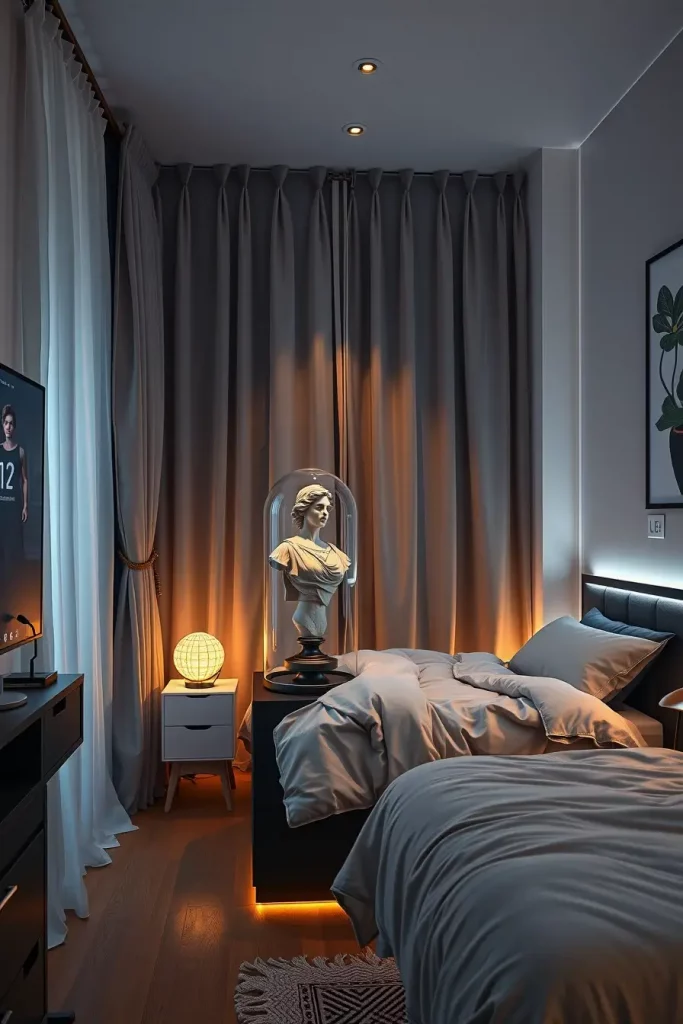
Each thing has to justify its footprint: a folding projector screen is also wall art with moving shadows; a thin console conceals cable management of smart lights; side tables can nest as risers of props, and then disappear. I prefer fabrics to be snug-one blanket, two pillows at most-and in a limited color scheme so the room does not appear cluttered.
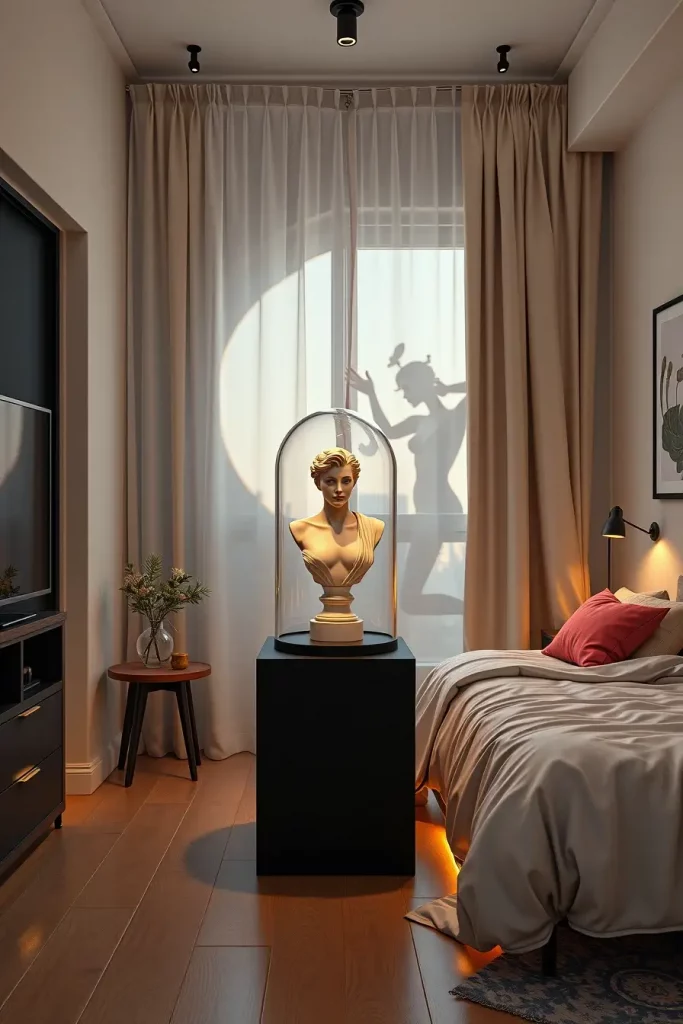
Small spaces are the worst victims of over-prop by people as it is experienced. The rule of thumb that is frequently proposed by US apartment stylists is the big move, small accents; I concur. I will choose one large oversized mirror or mural, and back it up with two or three more detailed pieces.
What I’d still add: a removable UV strip (under shelves or bed base) to flip a normal white room into a UV‑neon micro-haunt on party night—instant dual personality, zero bulk.
Maximalist Haunted Mansion Aesthetic: Layers, Luxe, And Over-The-Top Props
When I go maximalist, I will do: layered damask drapery, velvet sofas, tall candelabra, layered rugs, gilded frames, and too much baroque trims. It is the appearance that makes Halloween room decor feel like a movie and deliberately excessive. I compartmentalize the room reading nook, seance table, and gallery wall so that the maximalism is not unhinged.
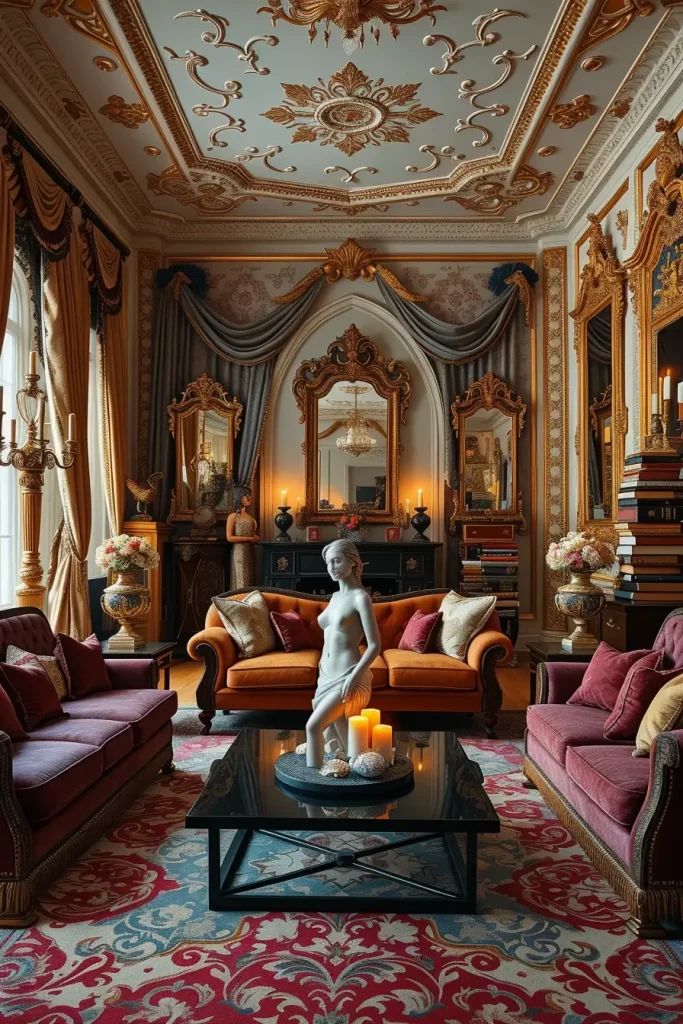
Each layer has a role: heavy curtains kill reflections and deepen shadows; antique gold mirrors bounce candlelight; stacks of books and busts build height changes; a central chandelier (with flicker bulbs) creates a theatrical “downlight” moment. I always add a tall, textural element (withered branches in an urn) to punctuate the verticals.
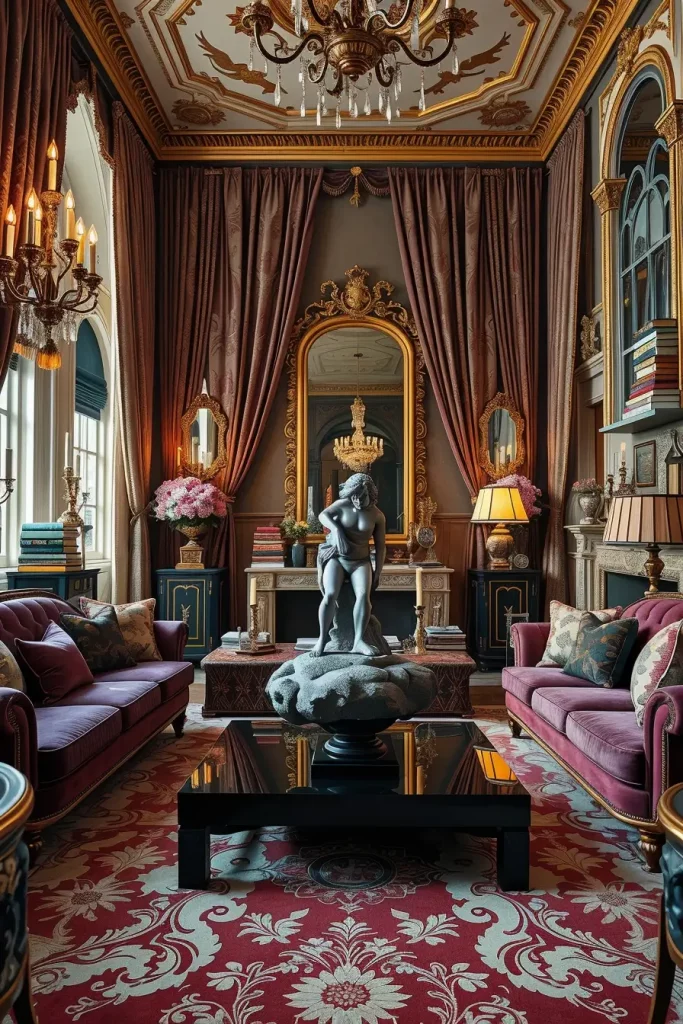
My take: the cost-efficient hack in this case is scale. One 7‑foot “stone” statue (foam, aged with paint) can replace twenty small trinkets and read far more luxurious. This is why set decorators that I admire tend to choose fewer and larger pieces.
What I’d still add: a single modern counterpoint (like a minimalist black steel coffee table) to keep the room feeling 2025, not a theme-park pastiche. The conflict renders it fashionable.
Cozy Cottagecore Halloween: Pumpkin Patch Textures And Candlelit Warmth
To make a soft, sustainable Halloween decorations take, I am turning to Cottagecore: knit throws, wool plaid cushions, carved wooden pumpkins, beeswax candles, dried florals, and baskets of apples and gourds. The color scheme remains warm rust, moss, cream, and pumpkin, so the room is welcoming and not shocking.
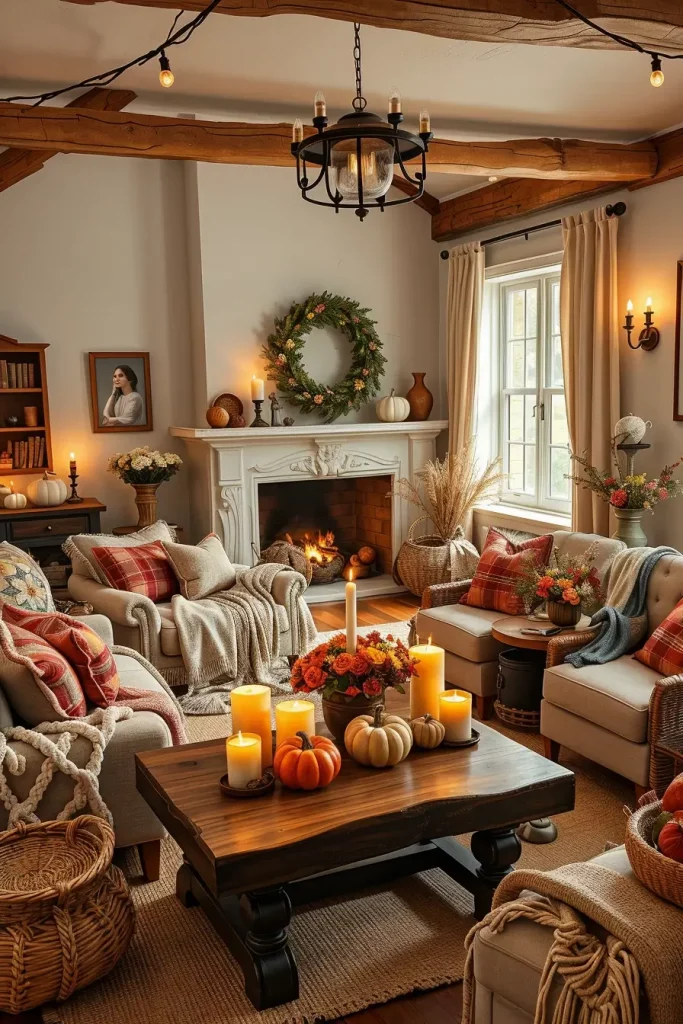
The furnishings and decor are tilted toward the touchable: knit poufs, unfinished-edge wooden side tables, ceramic mugs, linen table runners, and old apothecary jars of cinnamon sticks and star anise. I shall not omit a little fright a couple of cut-out bats, or a lamp of smoky glass but softly.
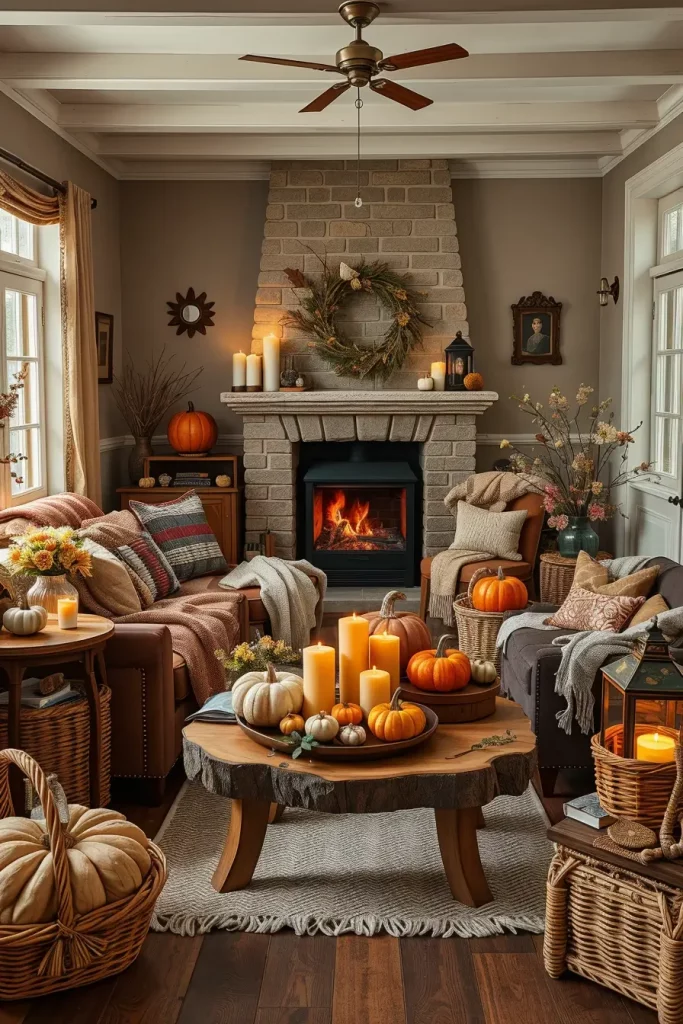
Professionally, I’ve noticed many US editors call for “texture first” when cozying a space (you’ll see it across House Beautiful and Domino). I go all in: anything that does not contribute warmth or touch fails to pass the test.
What I would include: washable cloth pumpkins and garlands made of natural fiber, so I do not have to purchase foam or plastic each year, and still have a charming design that fits my low-waste aspirations.
Glam And Elegant Black-Tie Halloween Rooms: Velvet, Crystal, And Metal Accents
This is where I change haunted to haute. I start with a restrained palette—black, ivory, onyx, smoke, and metallics (chrome, pewter, antique silver). Velvet sofas, crystal decanters, Lucite risers and thin brass candelabras provide me that black-tie sheen. It is the Halloween room decor ideas 2025 re-invented to cocktail parties and formal dinners.
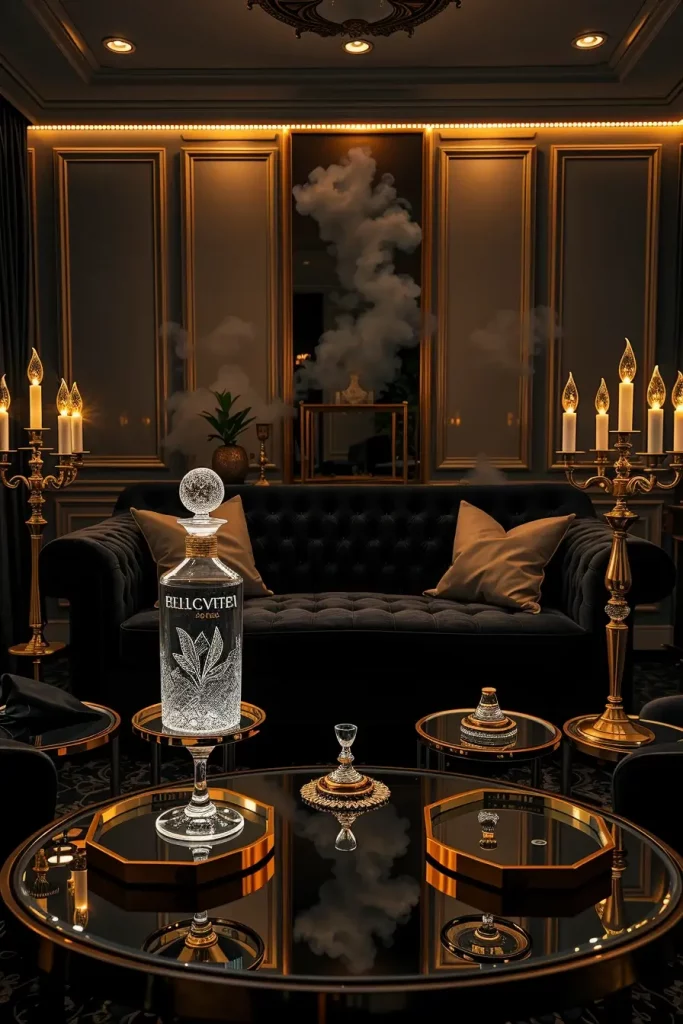
Everything is luxe: glass bead fringe on drapes, mirror-topped side tables, silk pillows with little spiderweb embroidery, and bone-white ceramic busts on polished pedestals. I like thin LED taper candles to maintain lines and ambiance under control.
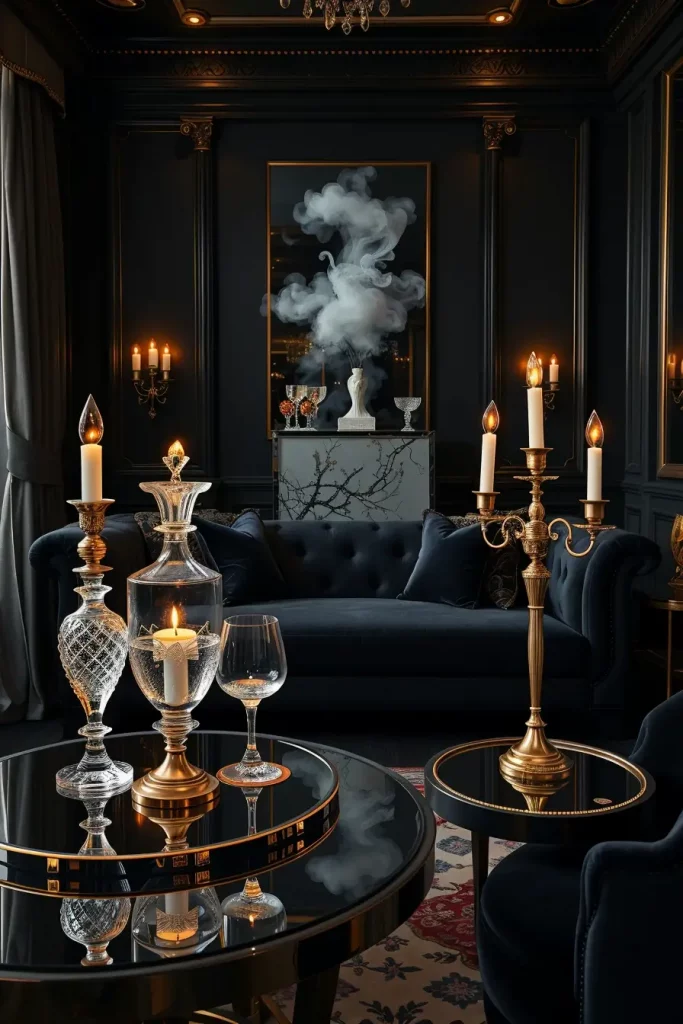
My take: self-control is opulence. As the most popular stylists say, it is better to edit than to add. I will select a maximum of 2-3 statement props per sightline and allow crystal and metal to reflect pinpoint light to create drama without a mess.
What I would add: a low fogger behind a mirrored plinth to give a ground-hugging, elegant mist, dramatic, yet still in the realm of evening wear.
Retro And Vintage Revival: 1920s Noir To 1970s Campy Classics
My favorite rooms are time-travel rooms: a 1920s film-noir parlor, with art deco lines, a 1950s atomic Halloween cocktail lounge, or a 1970s campy haunted basement with shag rugs and lava lamps. The secret is to create a coherent period and allow the horror language to ride over it.
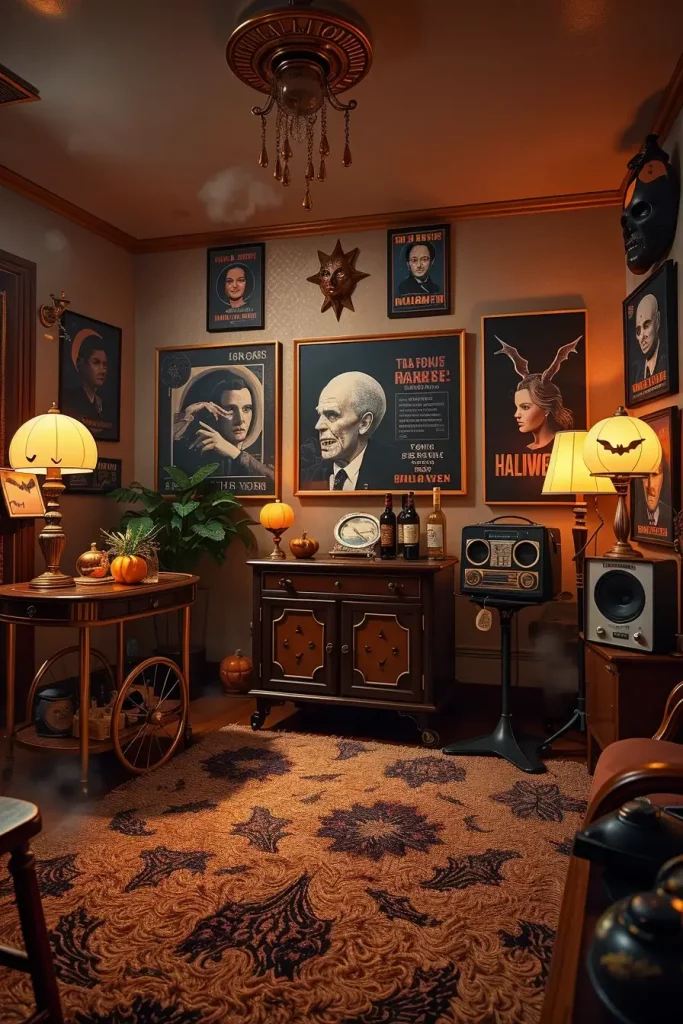
The furniture is the peg: a deco bar cart, mid-century credenza or retro modular sofa sets the time frame. Then I put in period-correct Halloween details black-and-white horror posters, reel-to-reel machines playing “ghost signals,” or orange-glow lava lamps with bat decals on them.
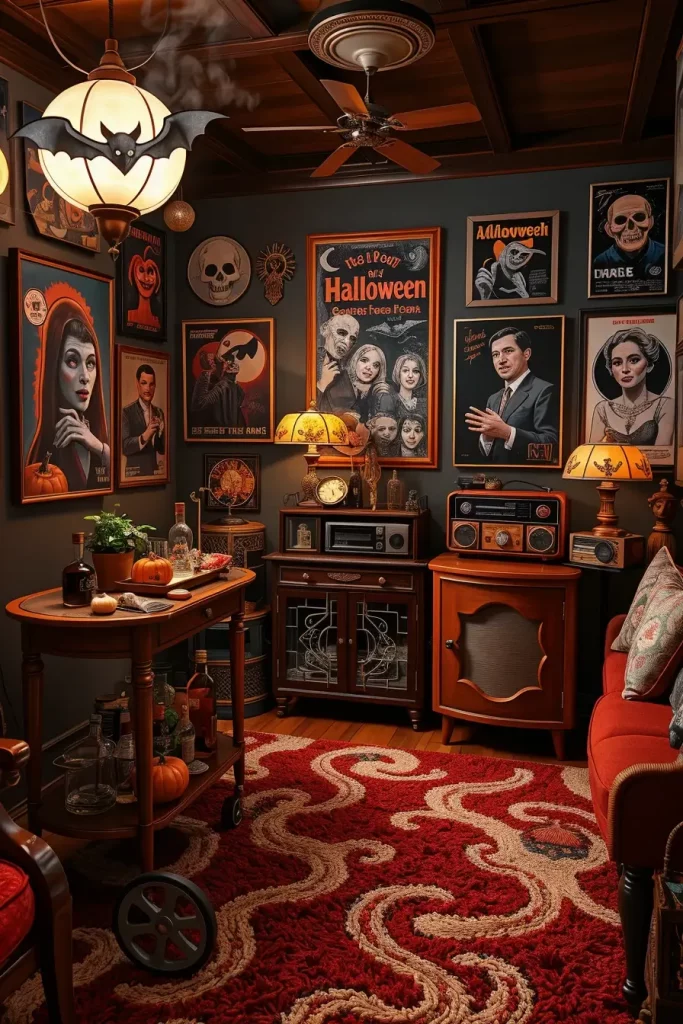
View: the bit sells on authenticity. I research (or thrift) a few genuine period elements—radios, lamps, or glassware—so the room feels grounded. Then I overlay the spooky narrative (fog, lighting, silhouettes) so it’s “retro, but haunted.”
Missing piece: a curated playlist through period-appropriate speakers (or disguised Bluetooth). Sound finishes the time capsule.
Witchcore Apothecary Shelves: Bottles, Labels, Herbs, And Smoke
I consider the shelving a working collection when I create Witchcore: amber-labeled bottles, dried herbs, smoky diffusers, brass mortars, beeswax tapers, and spell pages handwritten and placed under glass cloches. It is immersive, touchable, and can be stored year to year, which is ideal for the fans of DIY Halloween decor.
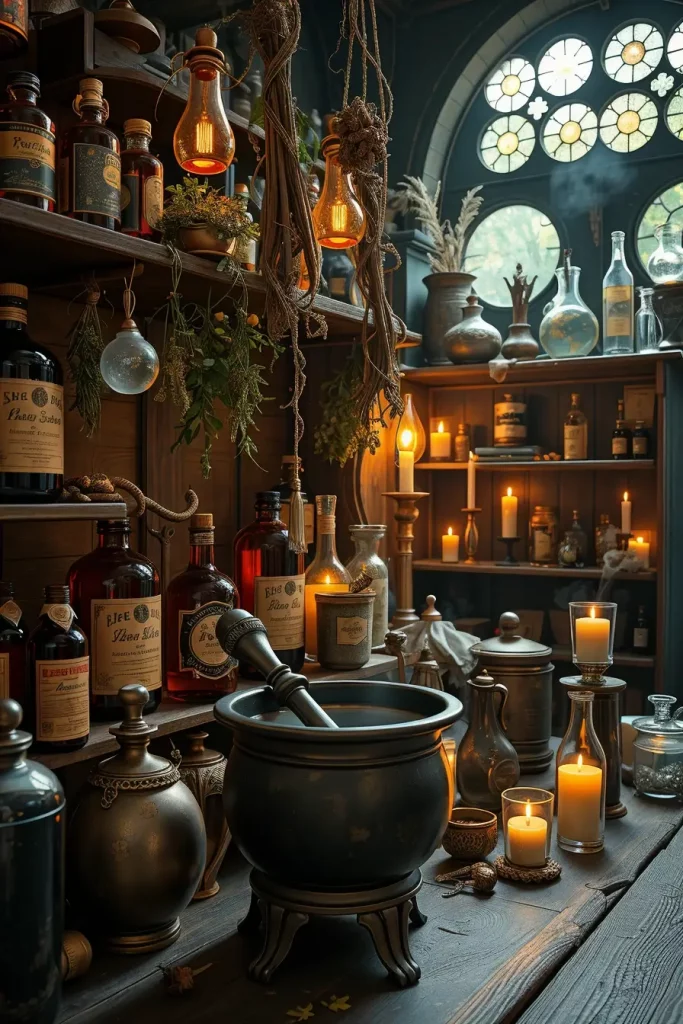
I categorise the inventory: tall bottles on high shelves, middle-sized tinctures at eye level, small vials in shallow drawers; herb bundles hang on iron hooks and a slate board has the list of elixirs to be offered to guests. I’ll add concealed LED puck lights (2000–2400K) for golden, firelight warmth.
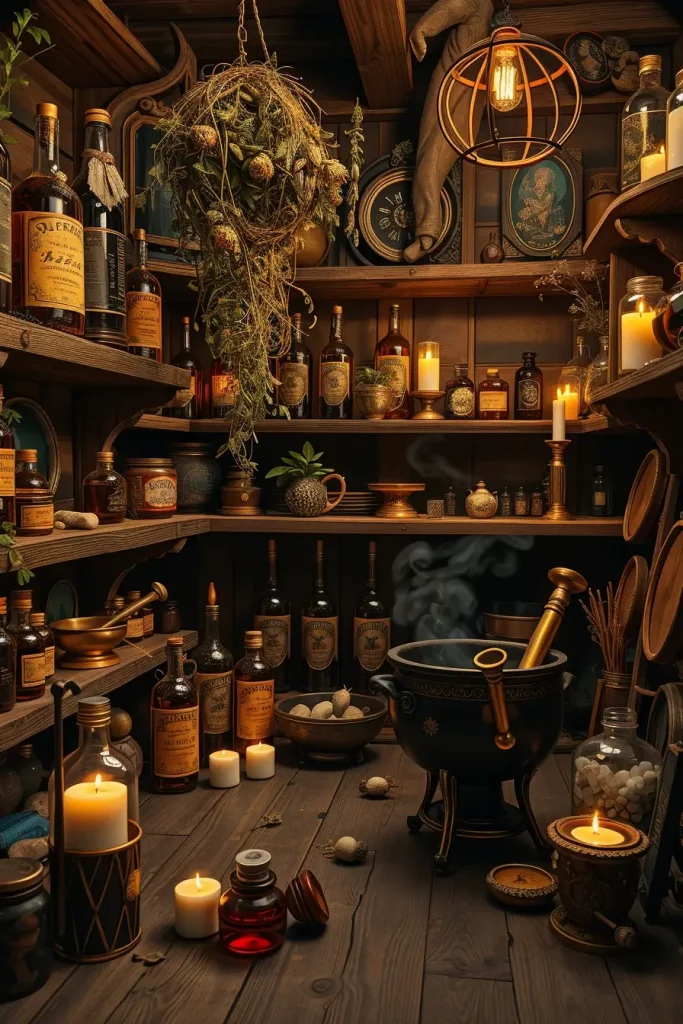
Professionally, I’ve found consistency in labeling (fonts, paper tone, aging technique) keeps the apothecary from reading messy. This is what many prop designers say treat your shelf as a line of products.
What I would include: a small ultrasonic mister in a cauldron to get occasional boil effects no heat, no danger, all drama.
The Skeleton Dance Party Room: Motion-Activated, Glow, And Humor
I always leave one room light-hearted, a Halloween room decor area that is silly, dynamic and repeatable. It has motion-activated skeletons, UV-reactive paint splashes, disco lights, and synchronized LED strips to Halloween remixes, which makes it the party nucleus.
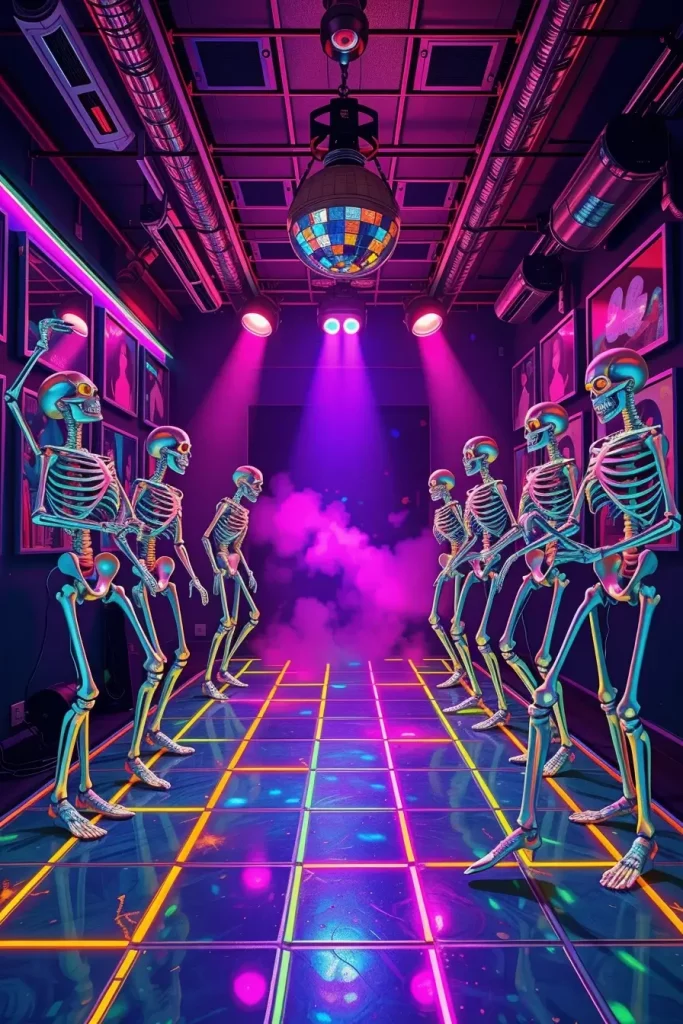
The set: skeletons on stands that are posable, glow tape dance floor grid, blacklight bar shelves, and a fog burst that is timed to a bass drop. I had a basic DMX or app-controlled lighting sequence to make the room act on command.
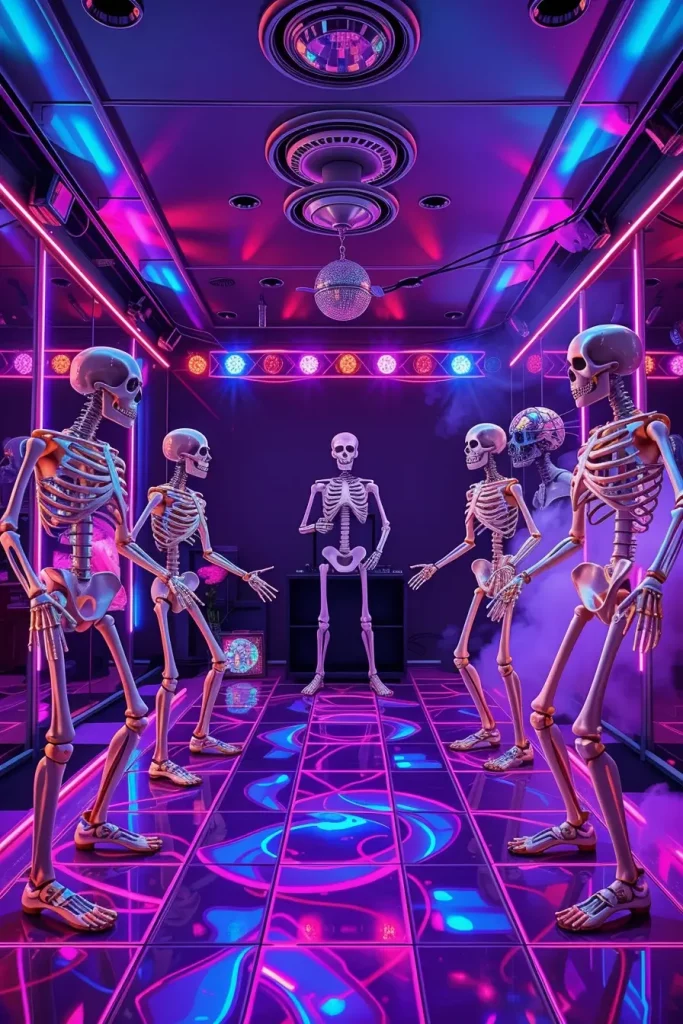
My take: humor is a design element- the scares are more pleasant when there is tension and release. Emotional arcs are frequently scripted by event designers in the US; I reproduce that at home with a high-energy comic room.
My addition: photobooth corner with reflective mylar, skeleton sunglasses, and skinny LED wands-content generator, as well as layered light in the space.
Pet And Baby-Safe Halloween Decor: Materials, Placement, And Alternatives
No Halloween decor scheme involving pets is ever started without first mapping the traffic areas and reach heights: anything a toddler or a cat with a curiosity can reach is out or redesigned. To decorate my halloween room in 2025, I will go soft, non-toxic, and flame-free: silicone or felt garlands instead of brittle plastic, LED candles instead of the real fire, and fabric decals instead of vinyl where off-gassing might be a problem. I also ensure that anything that is dangly is fastened using breakaway magnetic hooks, which means that there is no danger of choking or strangulation in the event that it is pulled.
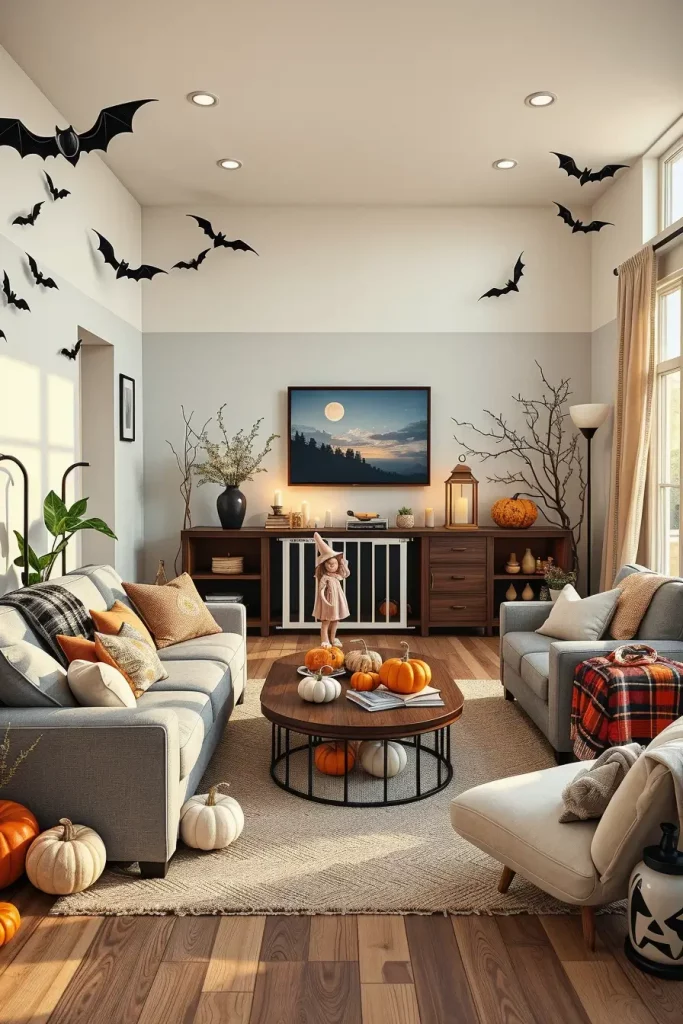
One by one, I will choose fluffy pumpkins made of cotton or boucle, EVA-foam bats rather than hard acrylic, shatterproof ornaments of the so-called mercury glass, and low-odor water-based paint on homemade decor. I skip glitter (microplastics and ingestion risks) and loose faux moss (tempting for both babies and pets). Floor-level decorations are placed in soft-sided baskets or behind transparent baby gates; tabletop vignettes are transferred to 90 120 cm height. Baby-friendly Halloween decor is all about moderation- the reward being the peaceful, non-busy eye candy that still packs the seasonal punch.
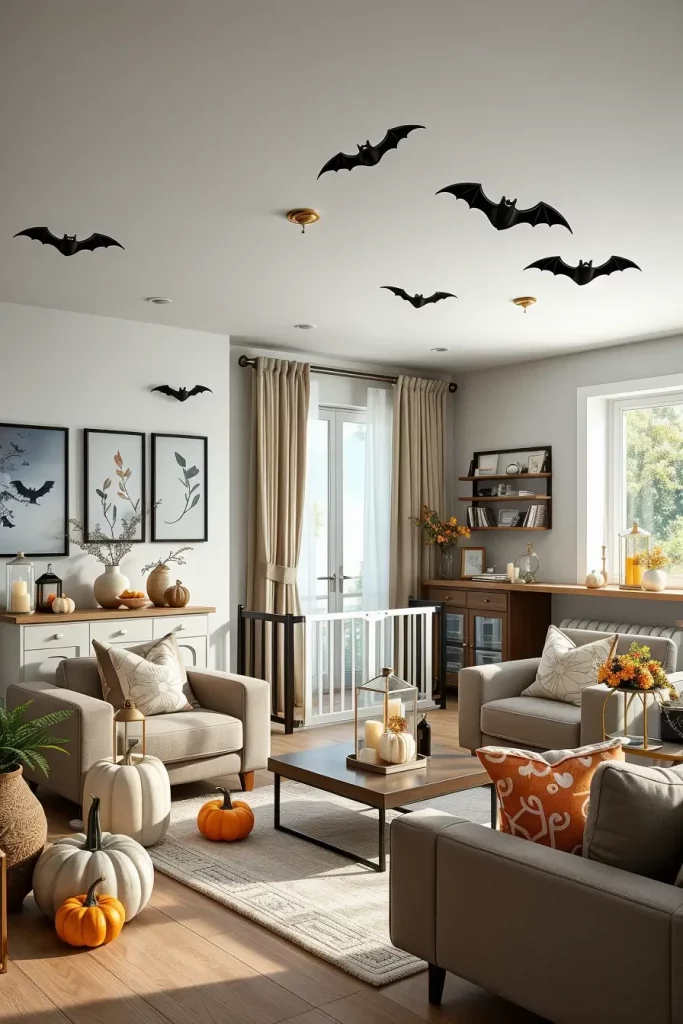
My personal experience, and what pediatric advice like the American Academy of Pediatrics general recommendation to avoid small, ingestible parts, keeps anything less than 4 cm in diameter out of reach, and I do not use cords that hang within a child-height crib. I have also found that pets are drawn to flicker and feathers, thus I substitute feather wreaths with felted wool and I use candle timer LEDs to reduce the continuous flashing that may over stimulate.
What I’d still add here: a checklist of “red flag” materials (brittle resin, wired ribbon ends, scented plug-ins) and a quick “swap list” (e.g., soy-based candles with covered lanterns, food-grade silicone spiders, sealed terrariums instead of open fake moss bowls). I would also suggest a speedy vacuum test- if the decor falls before Halloween night, it is not kid or pet friendly enough.
Budget Versus Splurge: Where To Save And Where To Invest In 2025
When I plan Halloween room decor ideas 2025, I split the budget into “trend-flexible” (save) and “longevity core” (splurge). Trend-flexible are the items you are likely to change in a year or two: wall decals, paper bats, themed pillow covers, faux webbing, and cheap window clings these are the areas you can afford to cut. Meanwhile, I invest in modular smart lighting (RGB LED strips/projectors you’ll reuse at Christmas or parties), durable outdoor-rated wreath bases you can re-style, quality velvet or boucle pumpkins, and sturdy lanterns that won’t chip or crack.
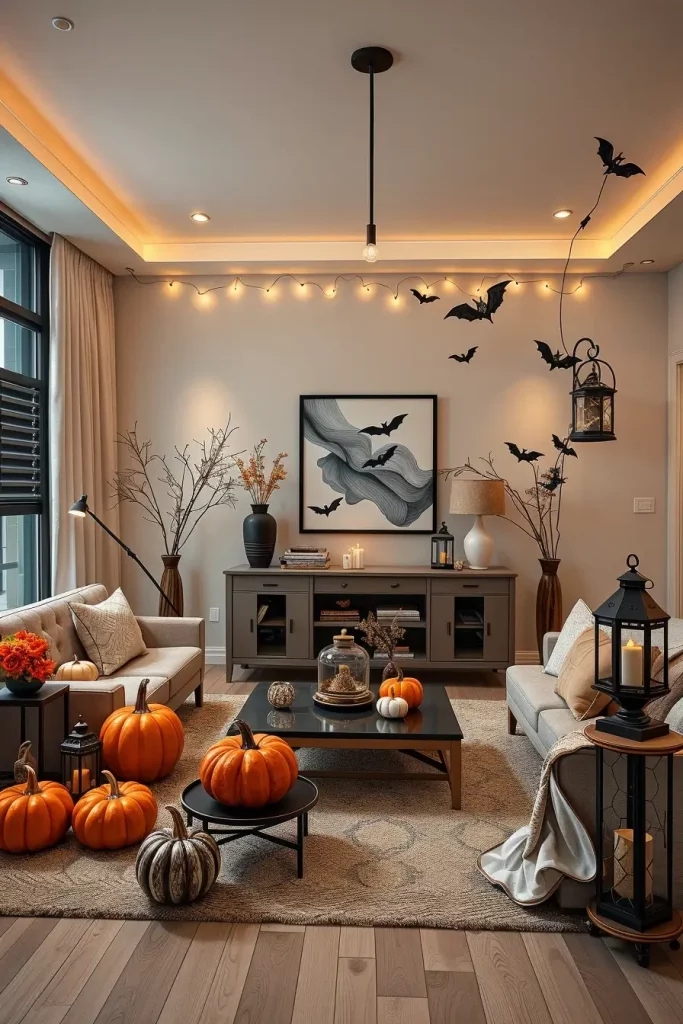
On a line-item level, I skimp on disposable paper banners, cheap foam tombstones (they crumble), and novelty tableware (rent or thrift instead). I indulge in a high-impact, multi-holiday tech, smart plugs, programmable spotlights, and a thin, foldable arch to the entry that can be adapted to other seasons. This will help to maximize ROI without making Halloween decorations tacky.
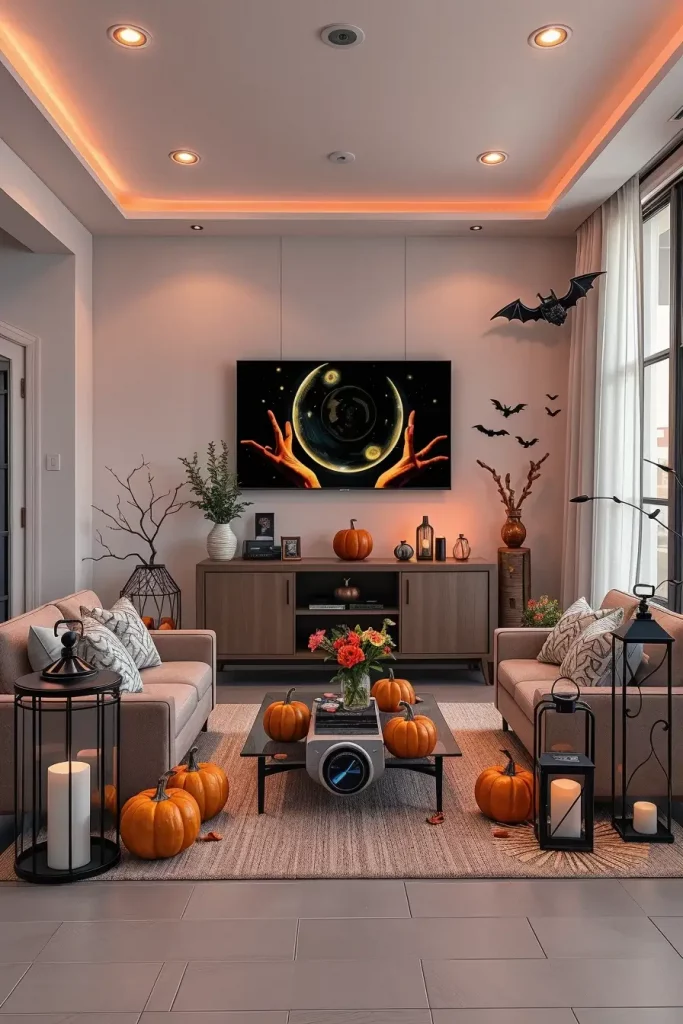
I have witnessed too many customers repurchasing cheap bins and strands of lights every year. My rule of thumb: If it’s touched more than 10 times (setup + teardown + storage), it’s worth investing in durability and ergonomics. I also compare the cost per holiday over five years- I would be happier paying 120 dollars on an RGB projector that I use ten times than 35 dollars on a prop that I use once.
The thing most people forget is to invest in label makers, QR code inventory sheets, and a small battery/smart plug drawer. Organization is an extravagance which will pay you the second year you decorate.
After-Party Storage: Flat-Packing, Labeling, And Modular Bins
I make the teardown on the same day I do the decor. It implies flat-packing garlands, folding fabric backdrops into vacuum bags, and modular, stackable bins that are the right size to fit your specific shelf depth. I prefer clear, latch-top polypropylene bins (acid-free if you’re storing textiles), and I add silica gel packets to every box with candles, faux florals, or anything that might absorb moisture.
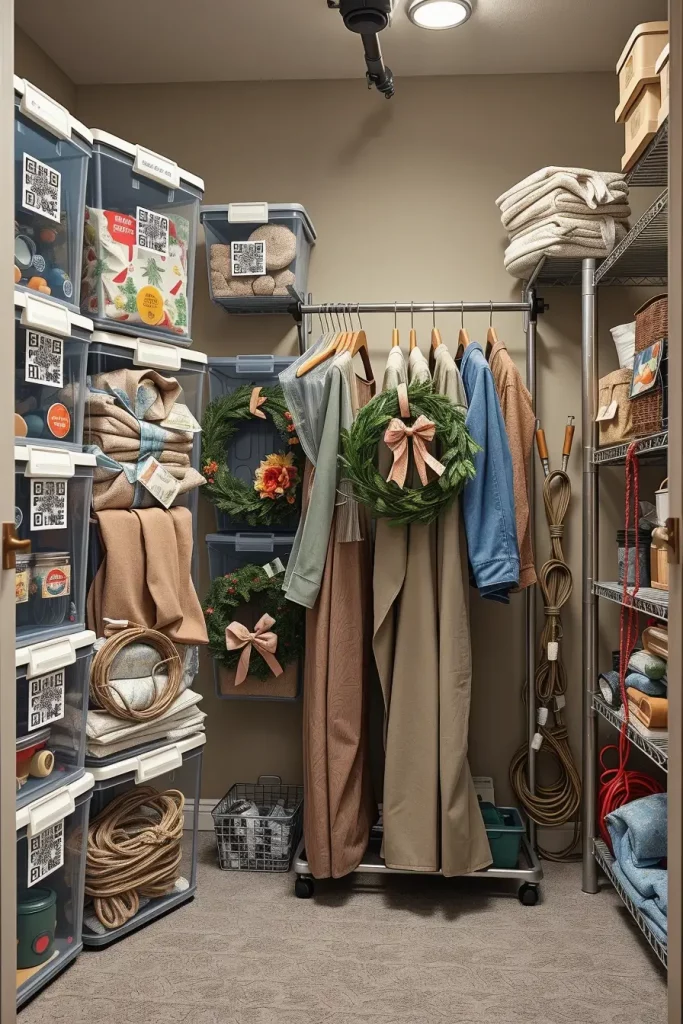
Here’s my item-level routine: every bin gets (1) a large text label on the long side, (2) a QR code tied to a Google Sheet or Notion inventory, and (3) a category code (LR = Living Room, BR = Bedroom, etc.). I pack heavy lanterns and ceramics to the bottom, fabrics and garlands into vacuum-sealed sleeves on the top. Strands of light are wound on cord reels, and then put in smaller inner bins to prevent tangling. When you are decorating several rooms with Halloween room decor, color-code the bin handles or stripe the tape by room.
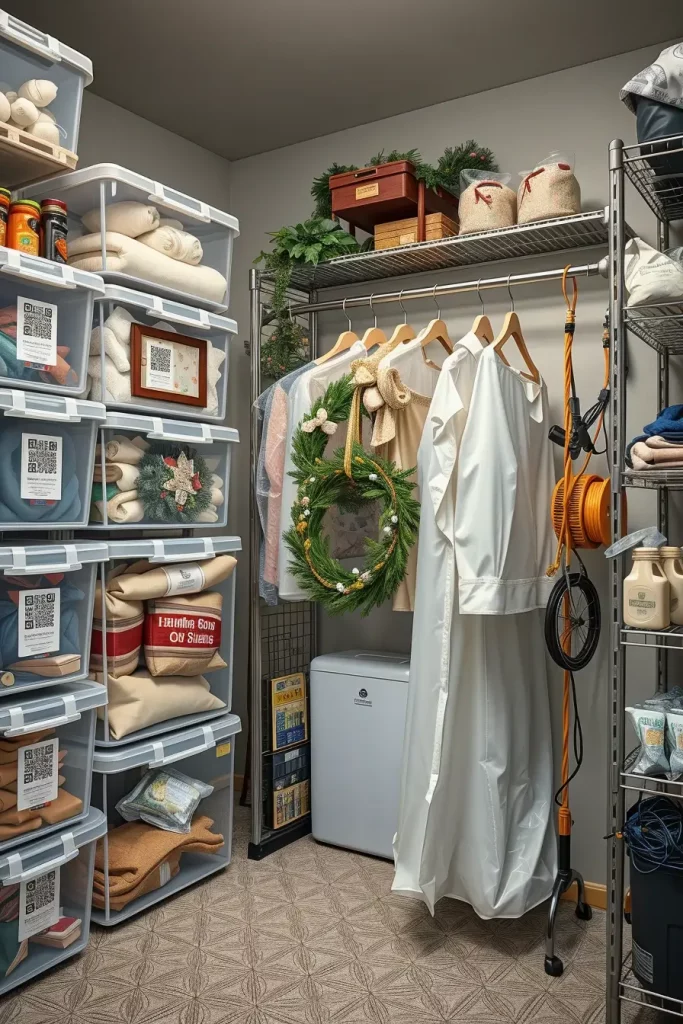
Based on experience, the largest waste is crushed wreaths and broken resin. This is why I put wreaths on the interior garment racks or put them standing up in garment bags with foam inserts. I have also switched customers to foldable PVC skeletons and foldable foam gravestones- less air, more space.
What I’d add: a teardown checklist that mirrors your setup order (reverse it, actually), plus a 10-minute “what to donate” rule as soon as you box up—anything cheap, faded, or never used goes now, not next year. You will be glad you did.
Room-By-Room Planning Checklist Template For Halloween Room Decor Ideas 2025
Before I buy one bat, I always develop a room-by-room planning checklist. For halloween room decor ideas 2025, here’s how I structure it in my planner: Room Name → Mood/Palette → Hero Piece (1–2 max) → Supporting Layers (textiles, lighting, wall accents) → Safety Constraints (kids/pets/traffic flow) → Storage Method → Budget Range → “To Buy / To Reuse / To DIY” columns. This system makes all the spaces consistent and prevents the panic purchases of late October.
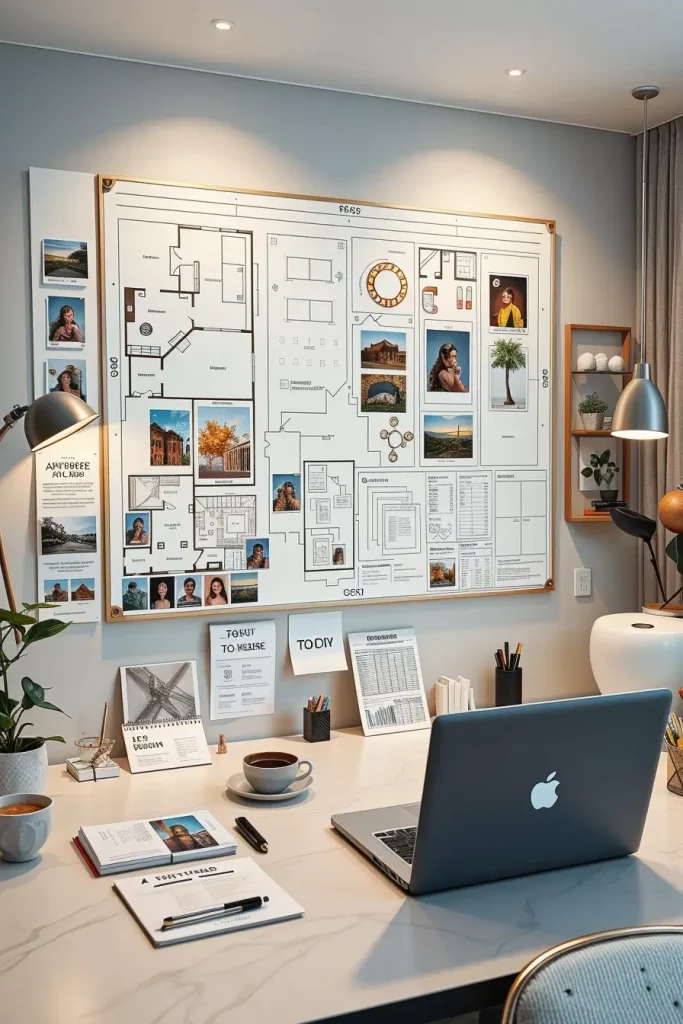
For each room, I specify: (1) focal lighting (spotlight, projector, or LED candles), (2) tactile textiles (throws, pillows, rugs), (3) vertical drama (frames, decals, tapestries), and (4) scent strategy (if applicable and safe). I also draw the location of cords, where gates or barriers should be placed, and where I will set up high-touch bowls or candy stations to guests.
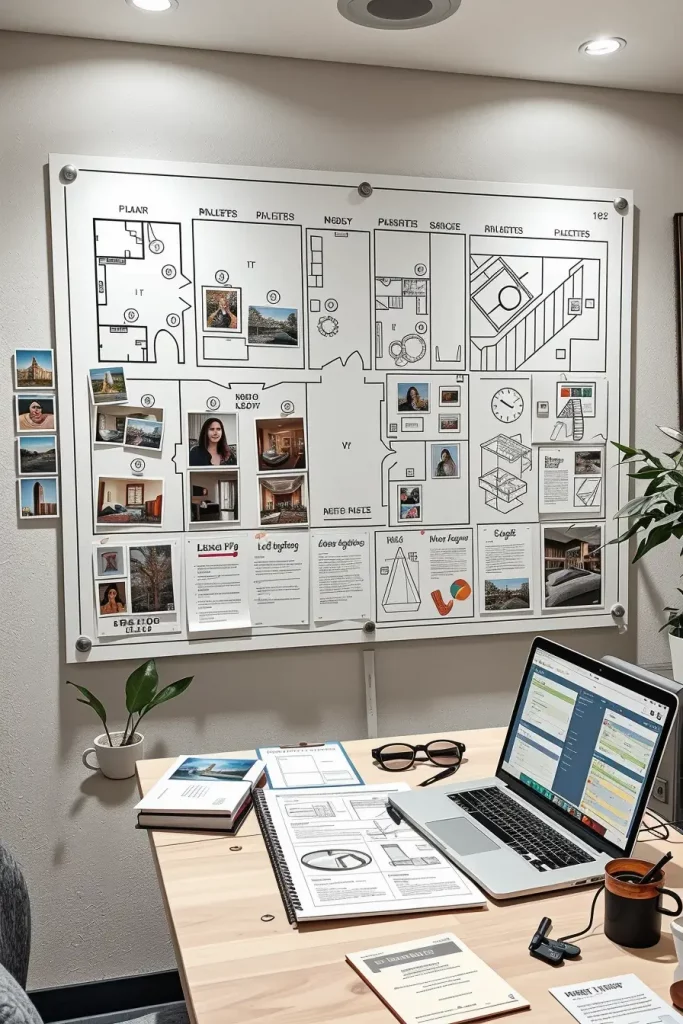
From my own practice, committing to a tight color story per room (e.g., charcoal + bone + oxidized copper in the living room; amethyst + black in the bedroom) prevents visual noise. I have stolen a rule of editorial stylists: one hero, two supporting actors, all the rest are extras. It is also what the best interior editors in the US repeat over and over again- clarity is better than clutter.
Add to this template: a micro-inventory field—how many pieces of each category you plan to show (e.g., 6 candles, 2 garlands, 1 wreath), and a lighting “modes” note (pre-party, party, post-party evening). Then you can turn the ambience up or down fast, without having to rearrange the room.
No matter what you are focusing on, whether it is safety, budgeting, storing, or planning every room to the perfection, Halloween room decor ideas 2025 can be elegant and efficient. I’d love to hear how you’re decorating this year—drop your favorite tip, question, or room theme in the comments below!
